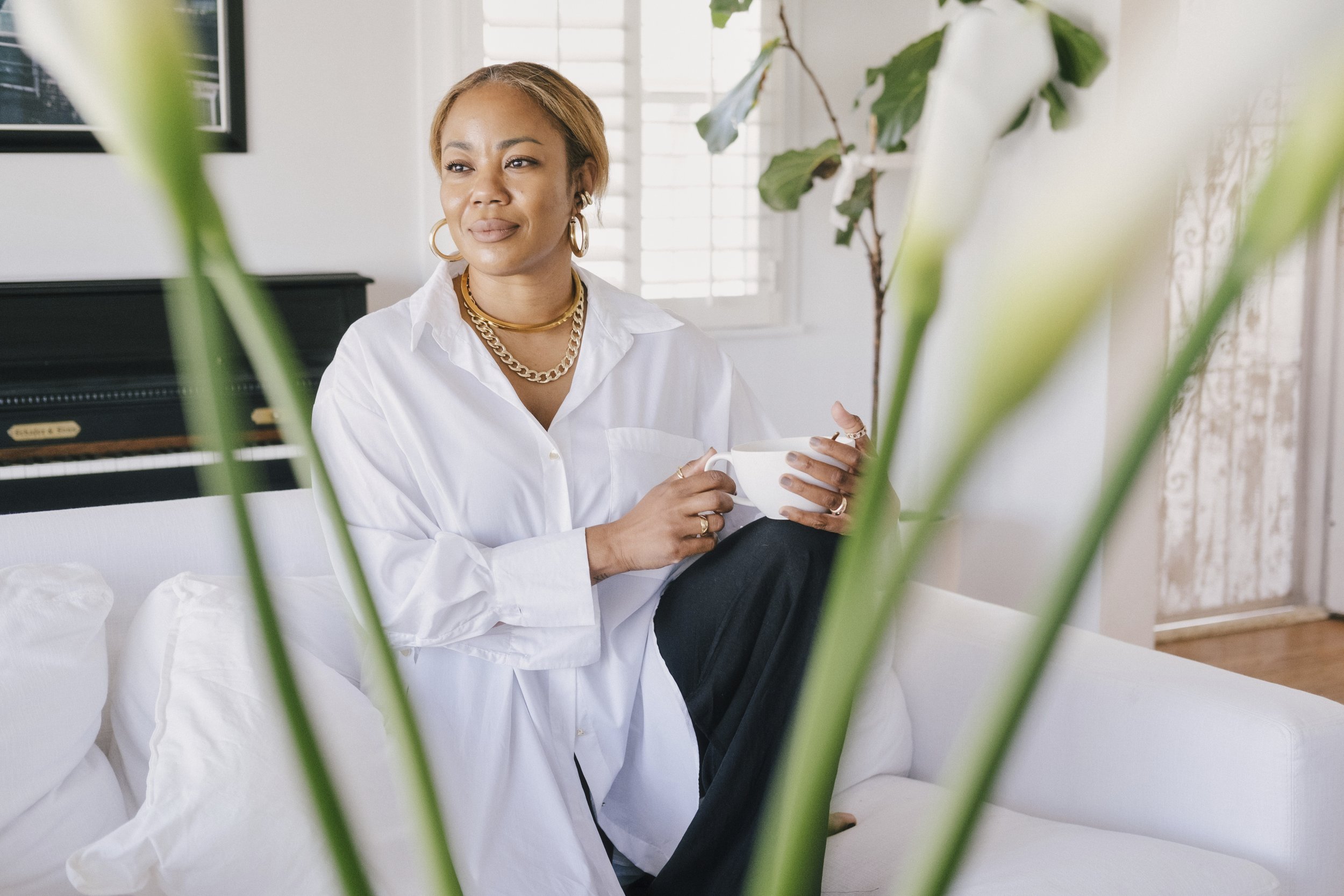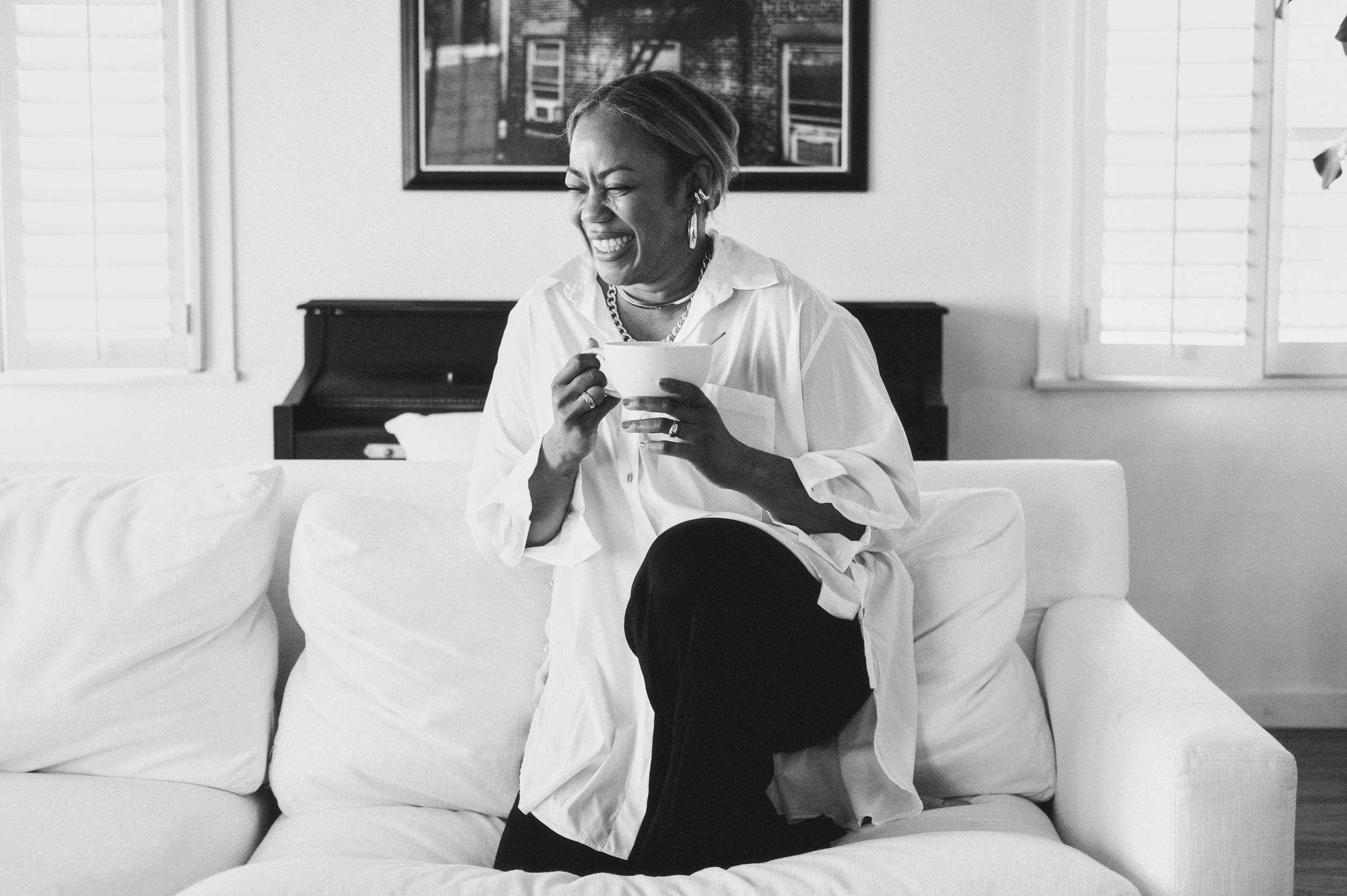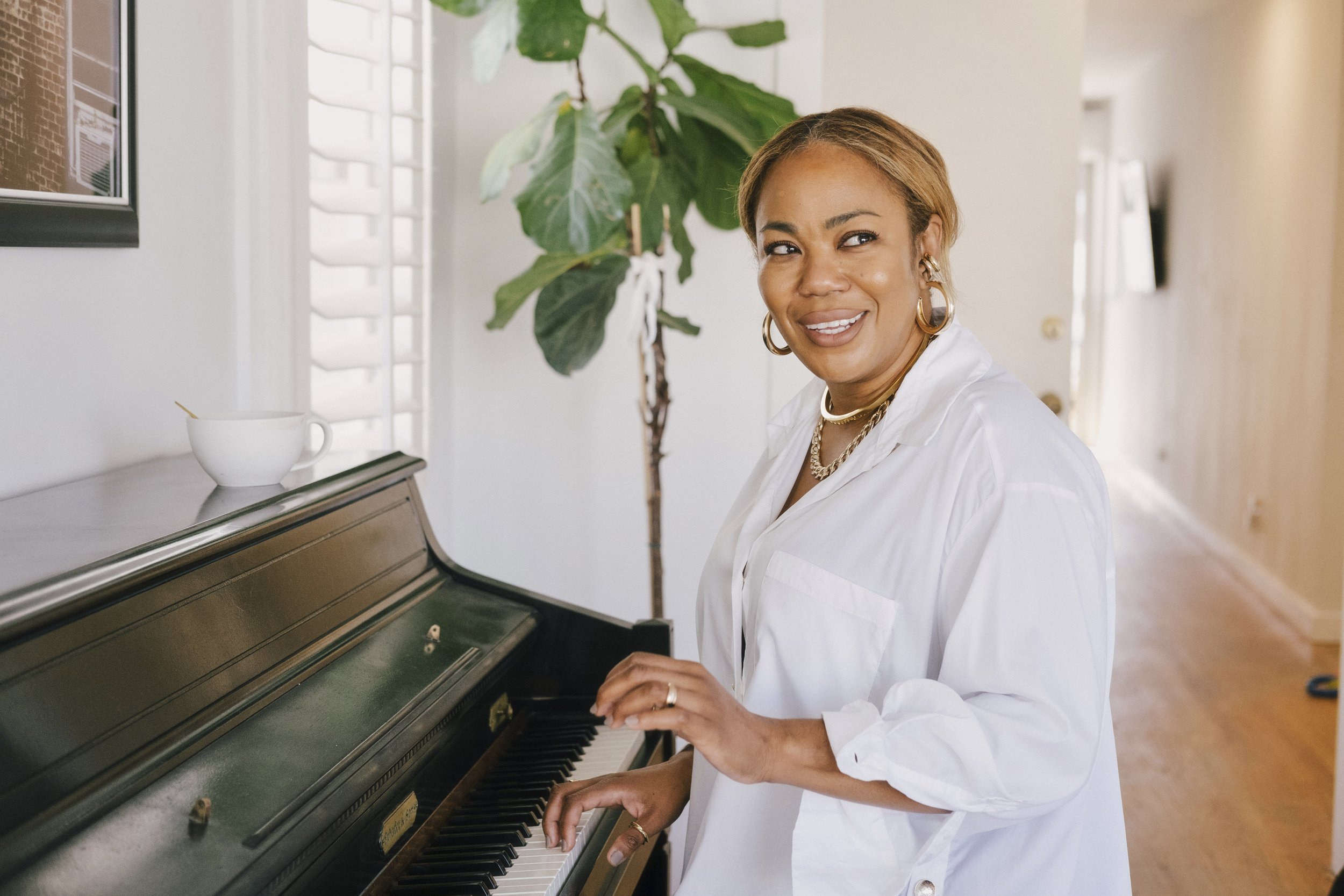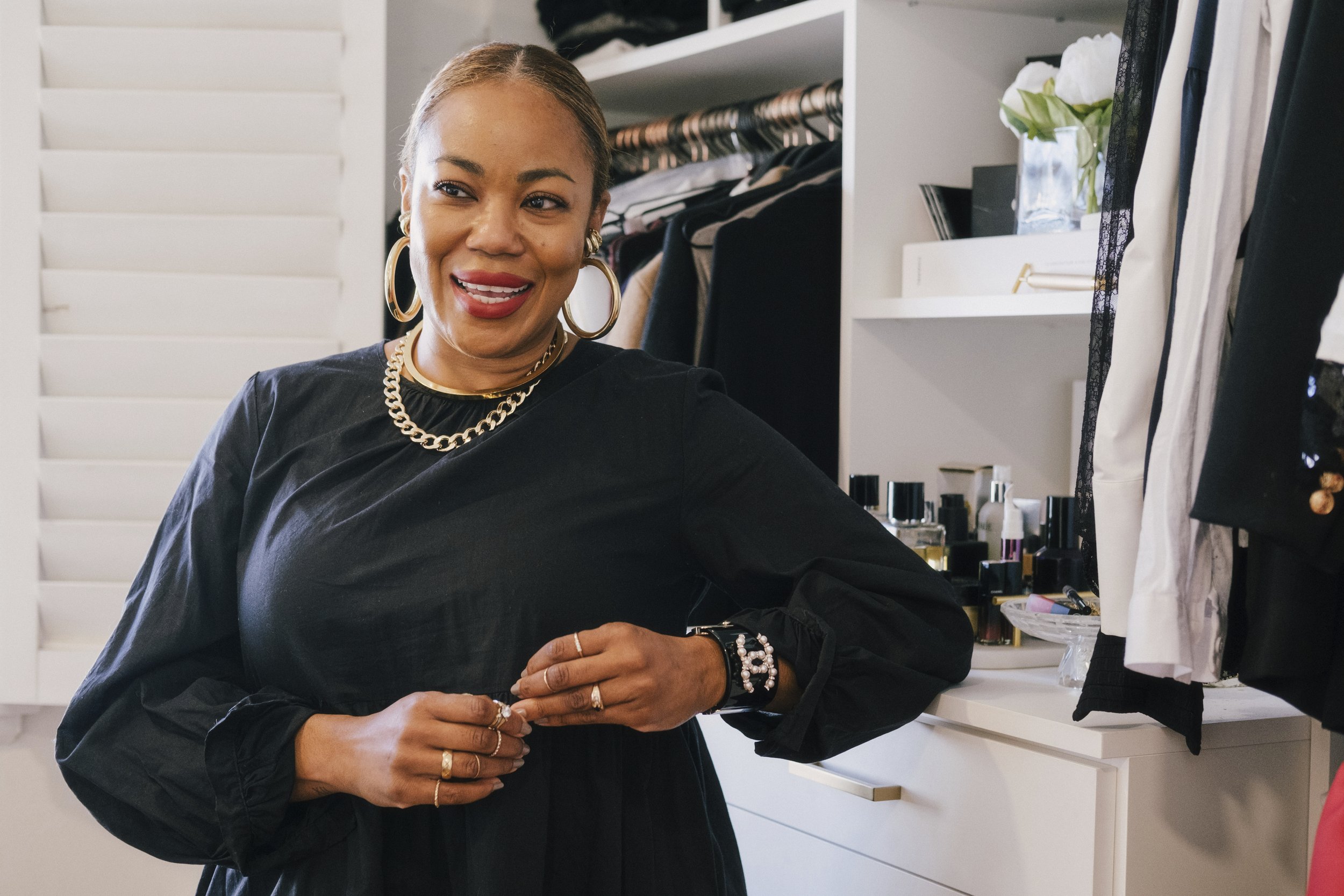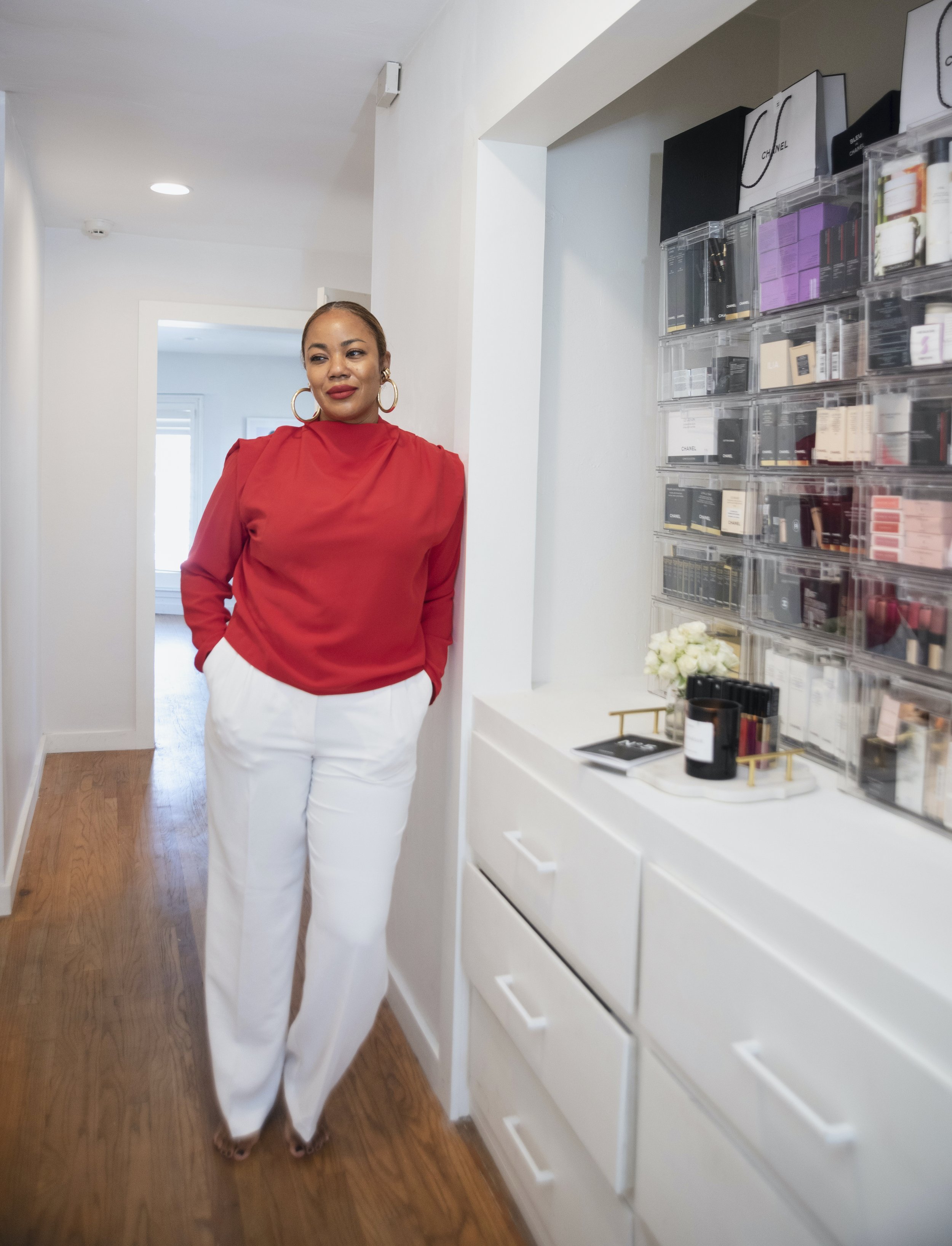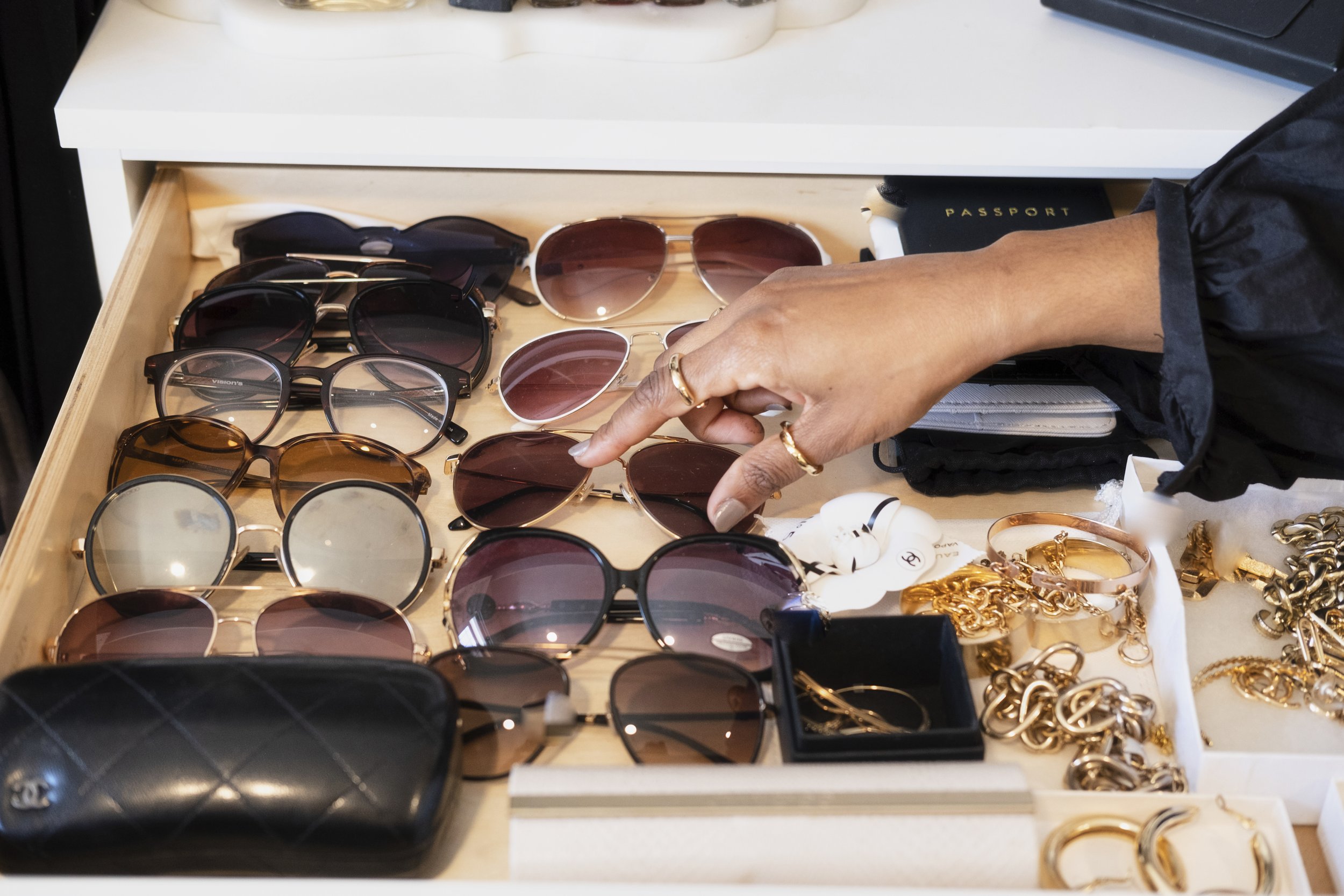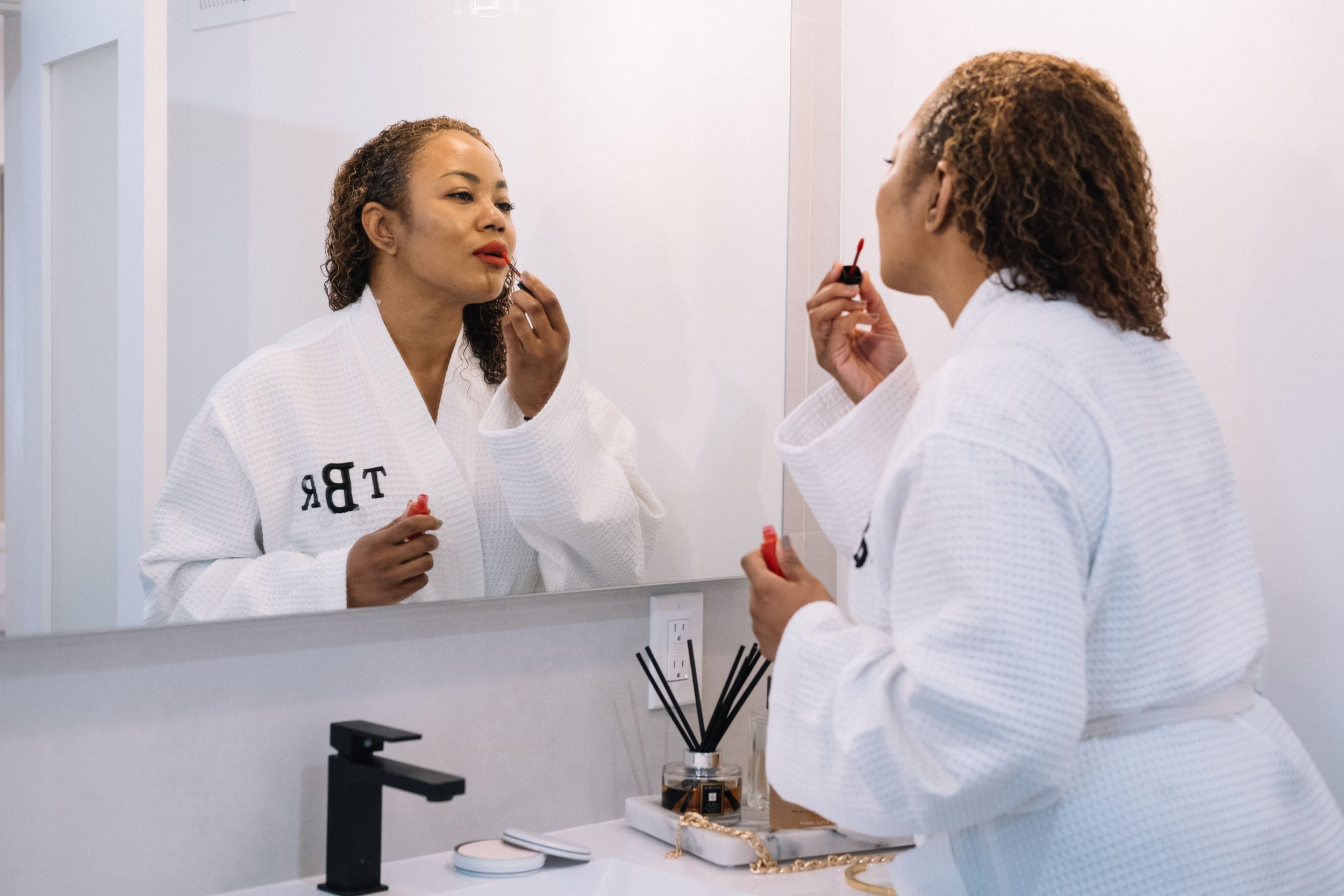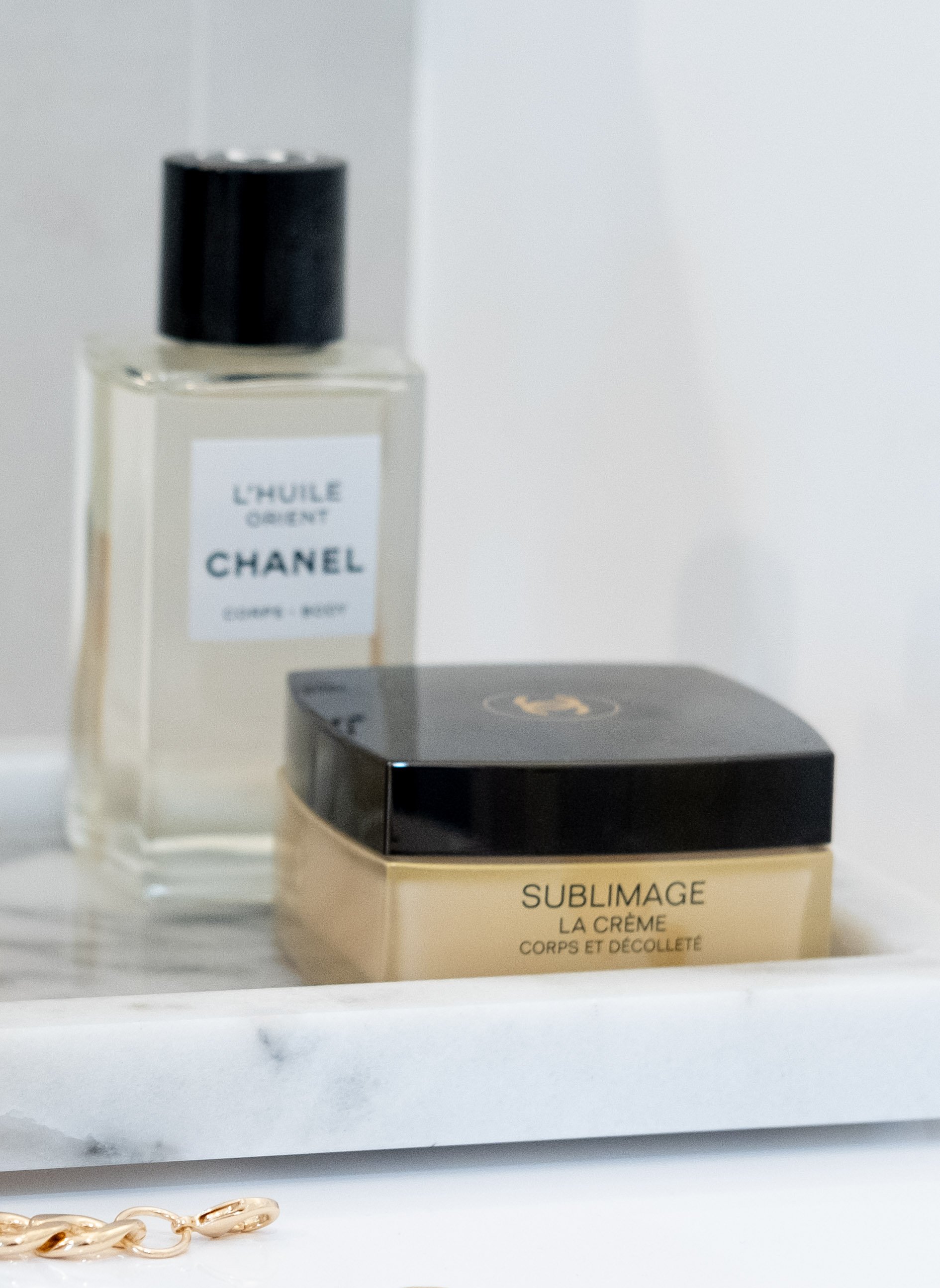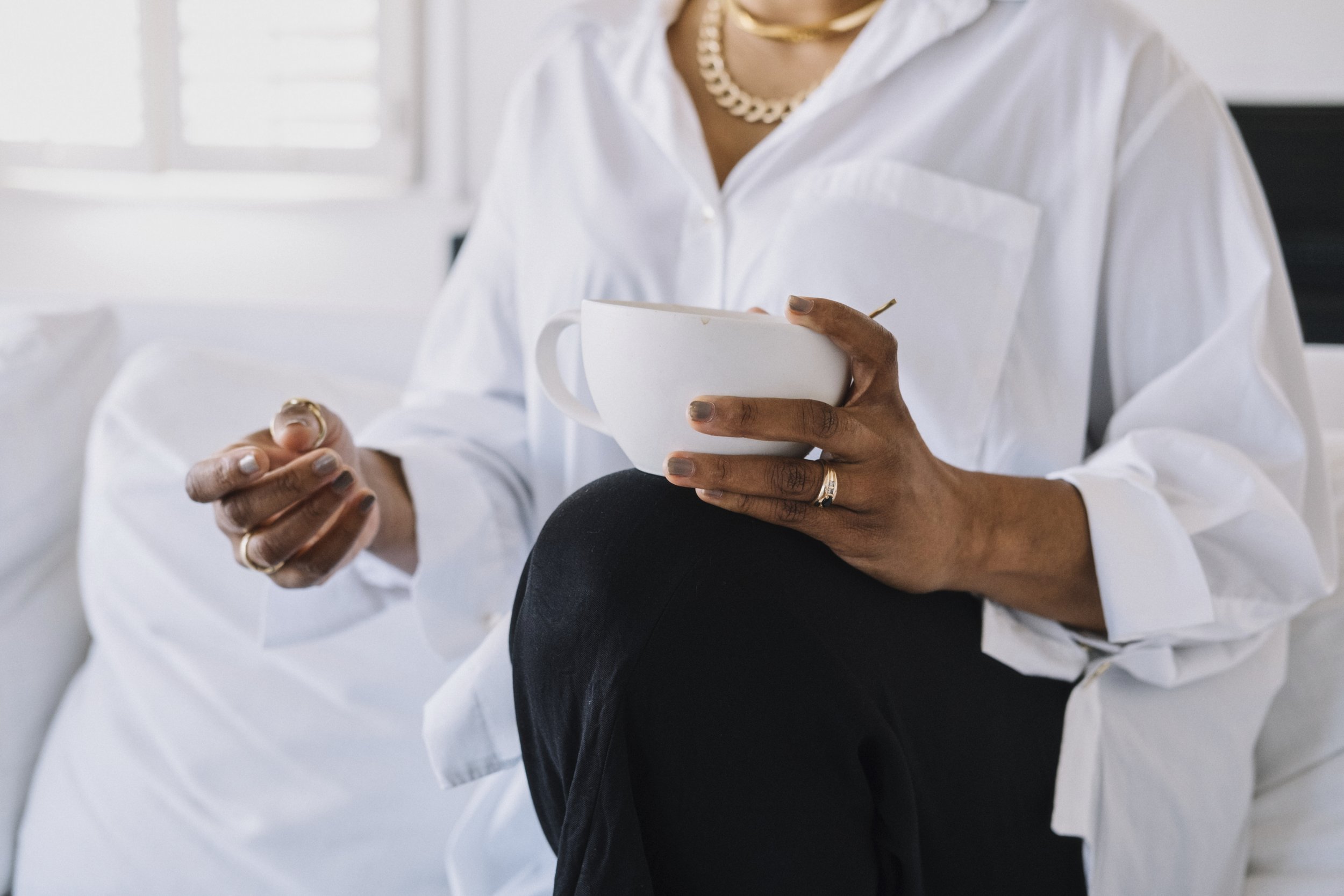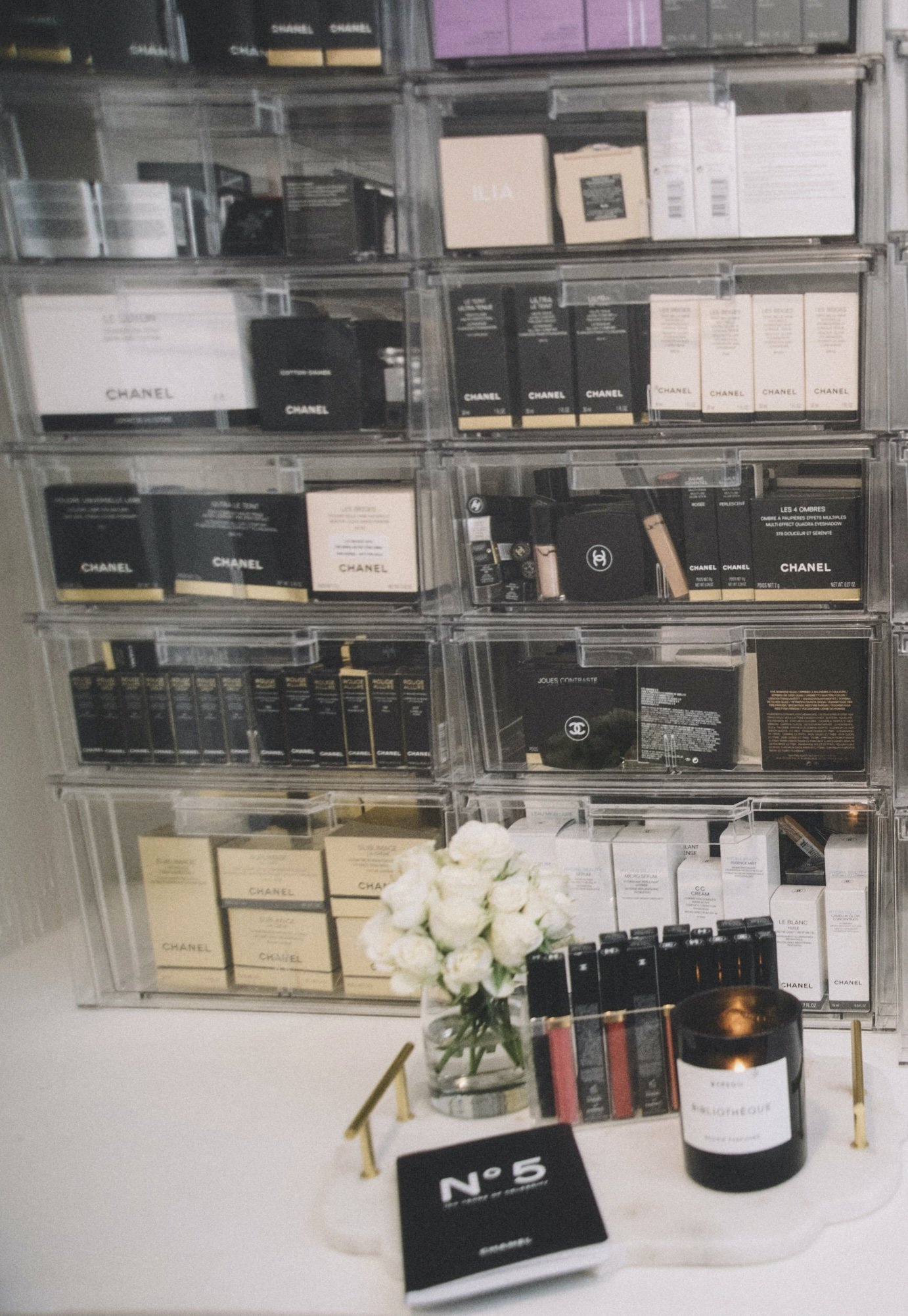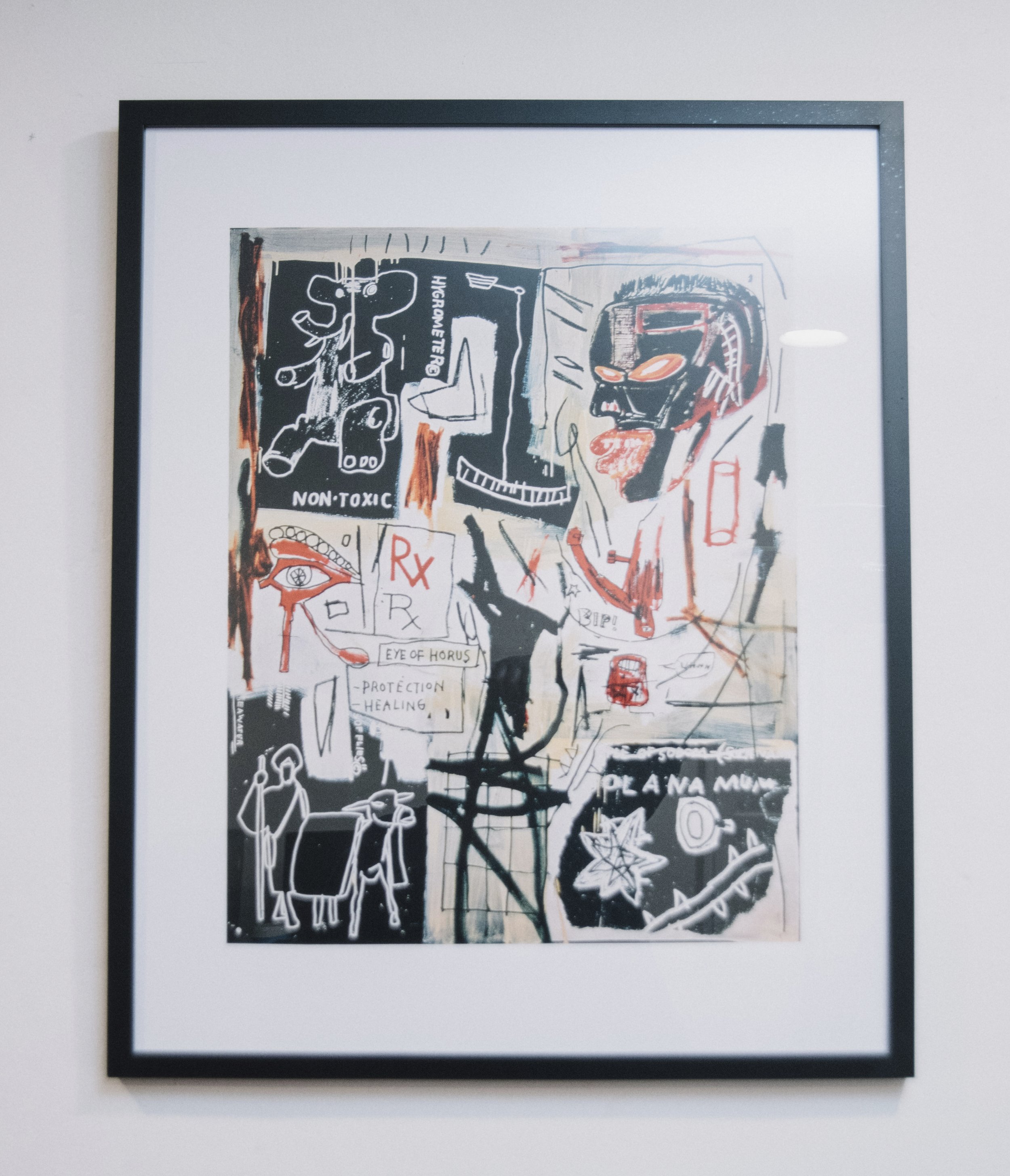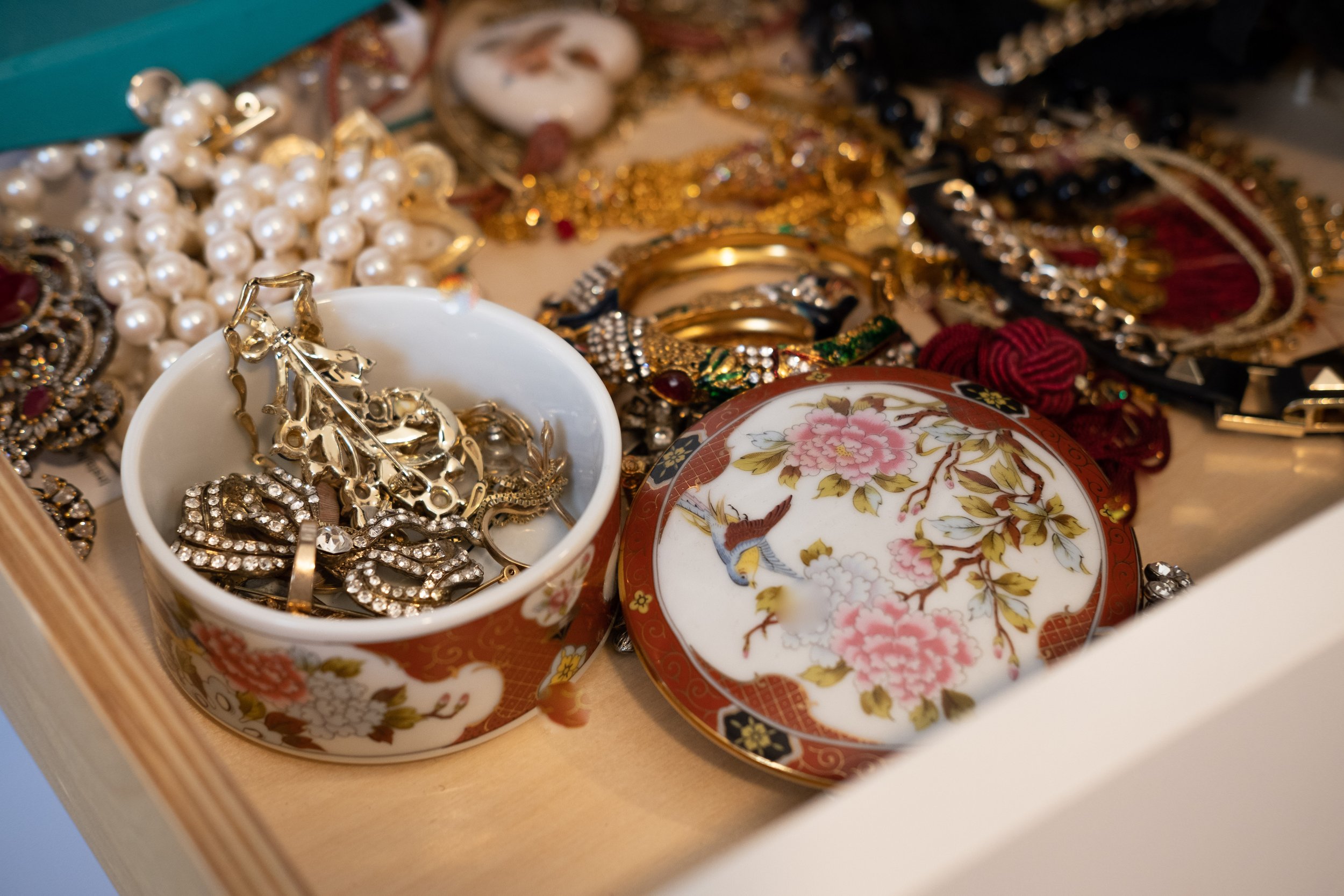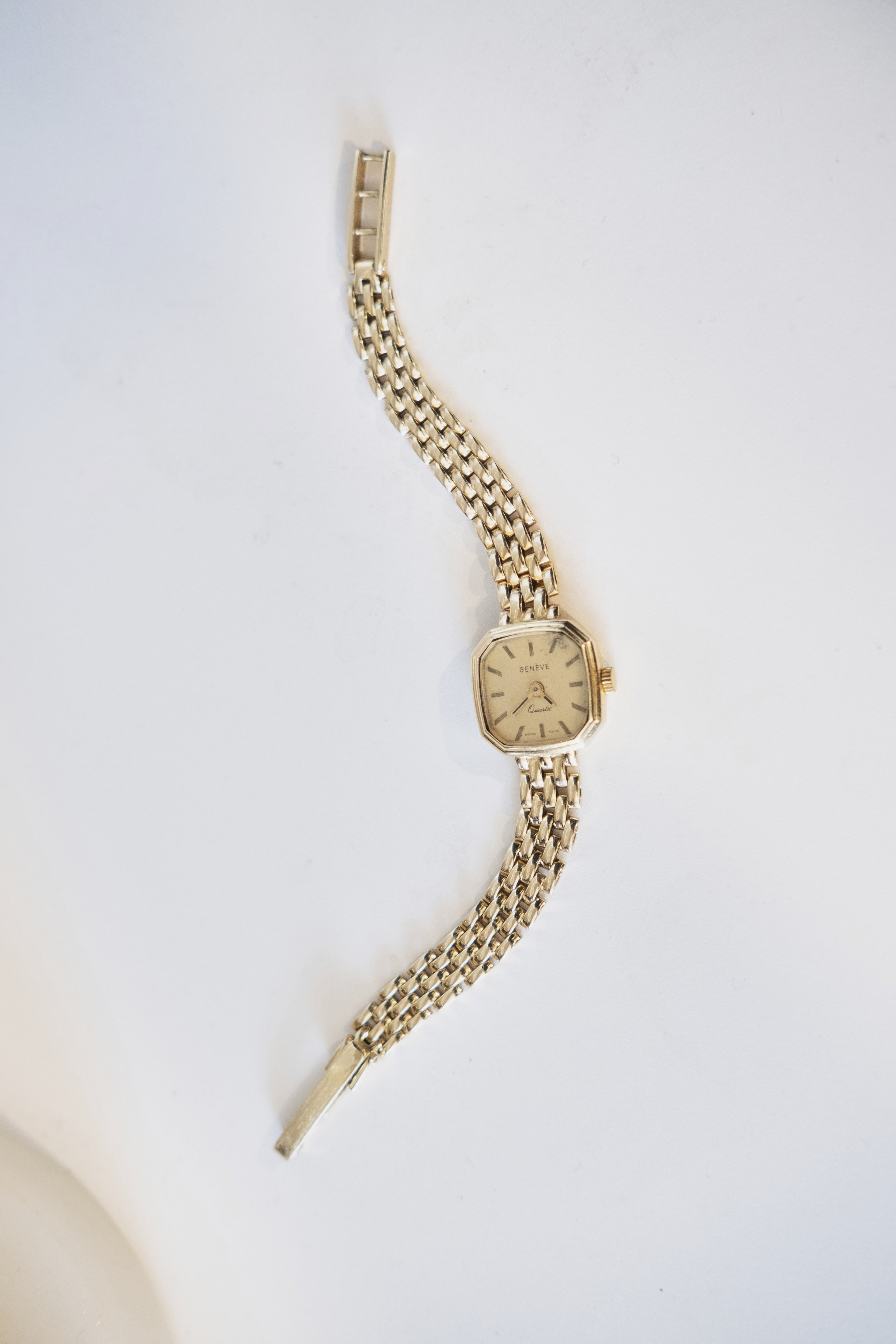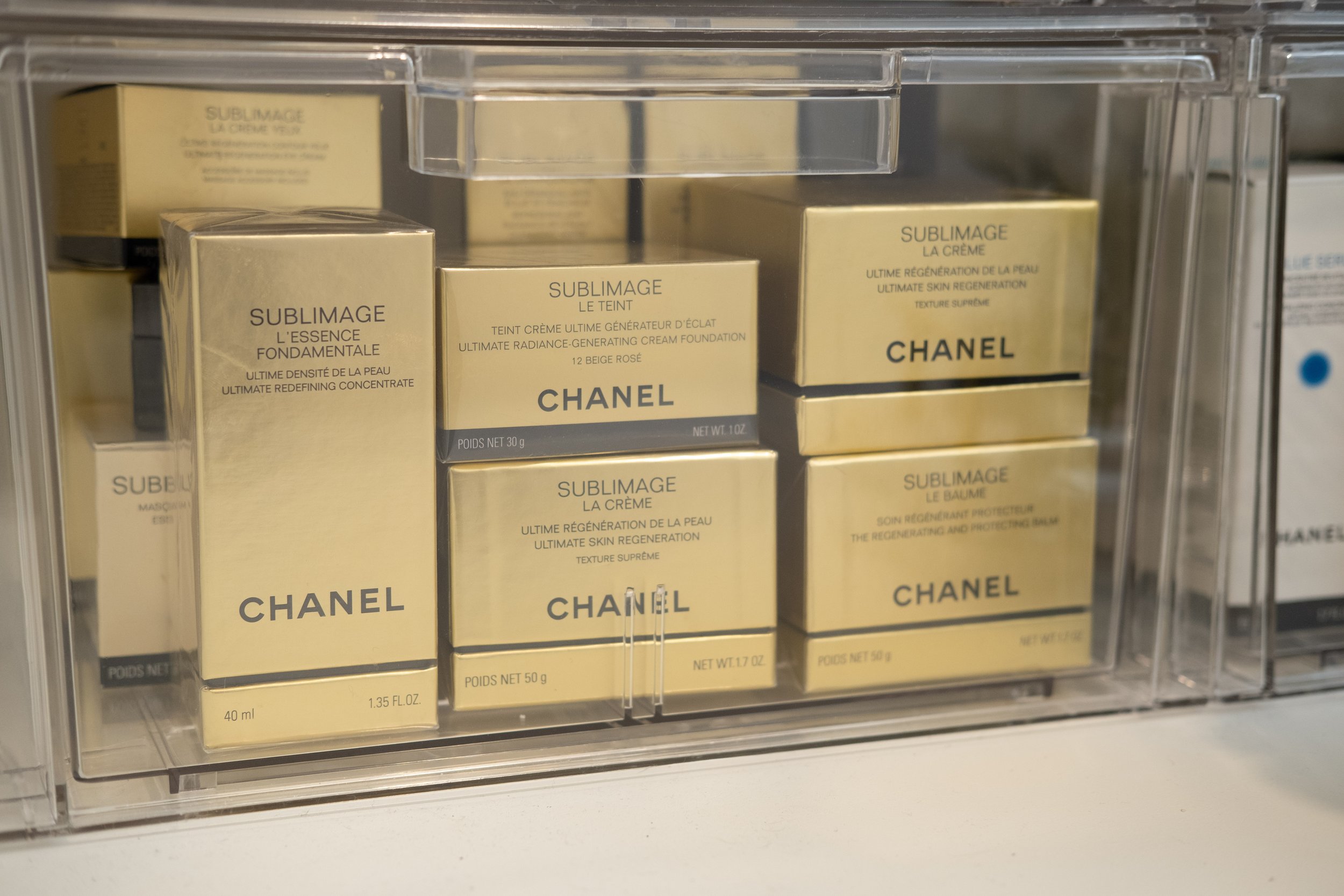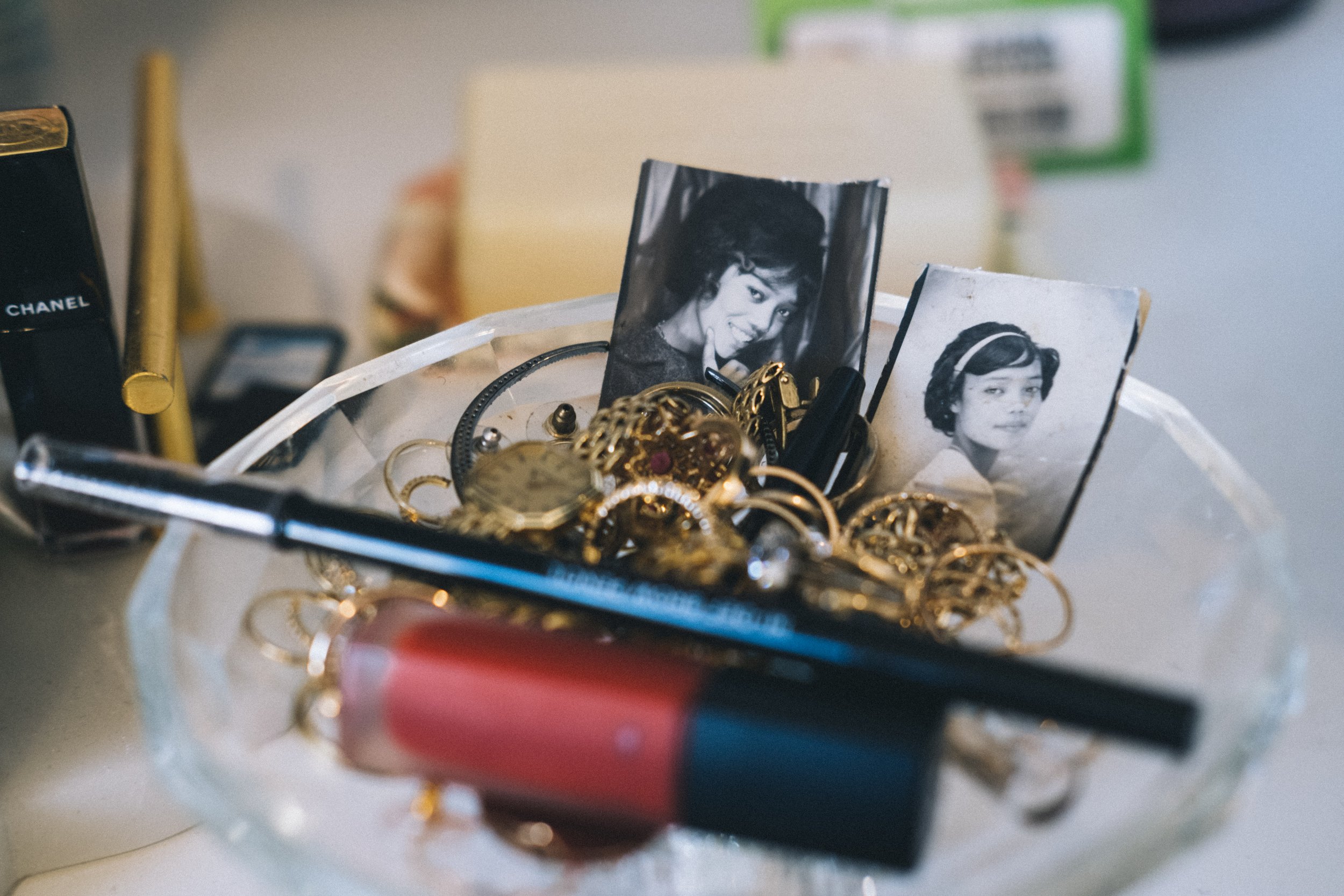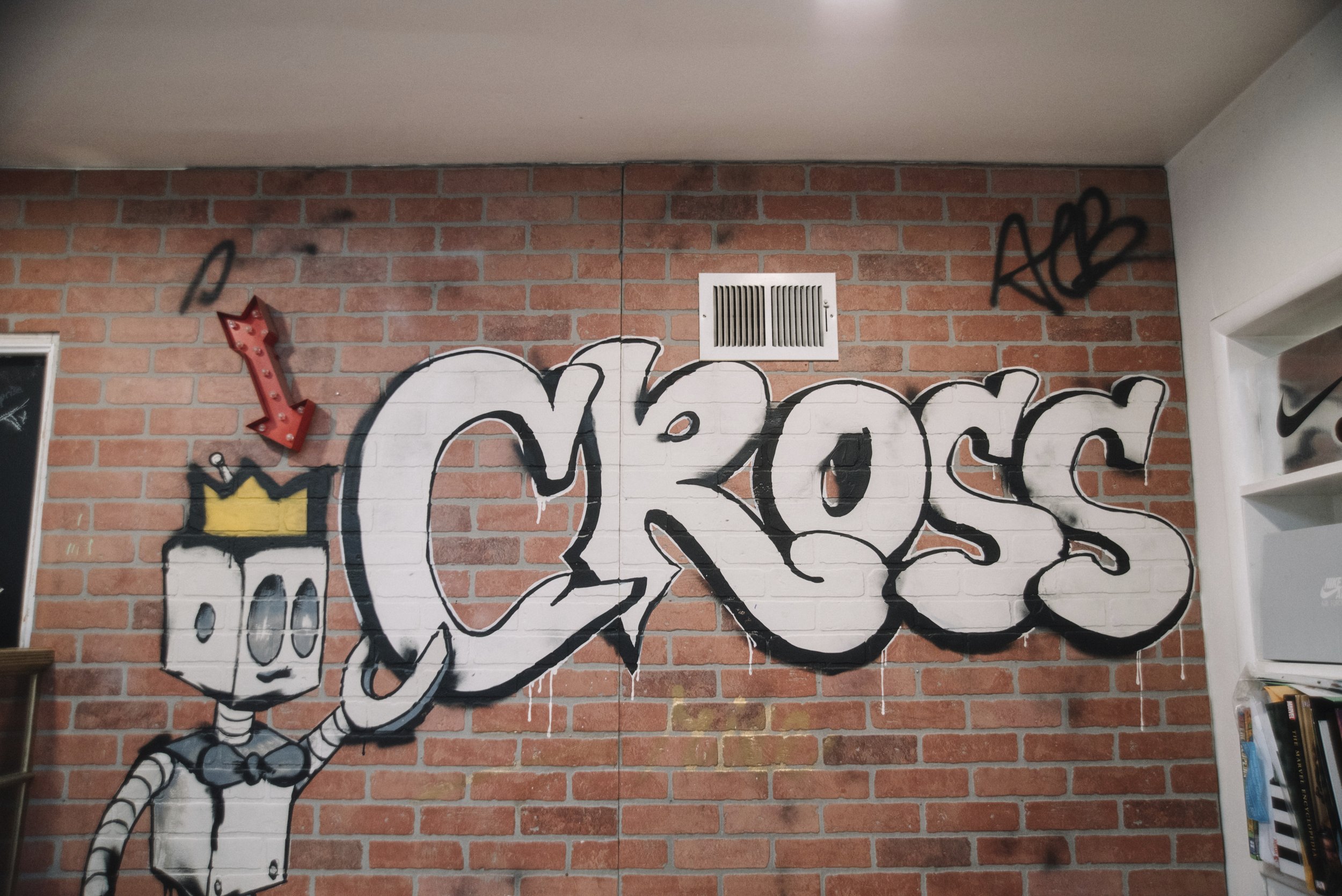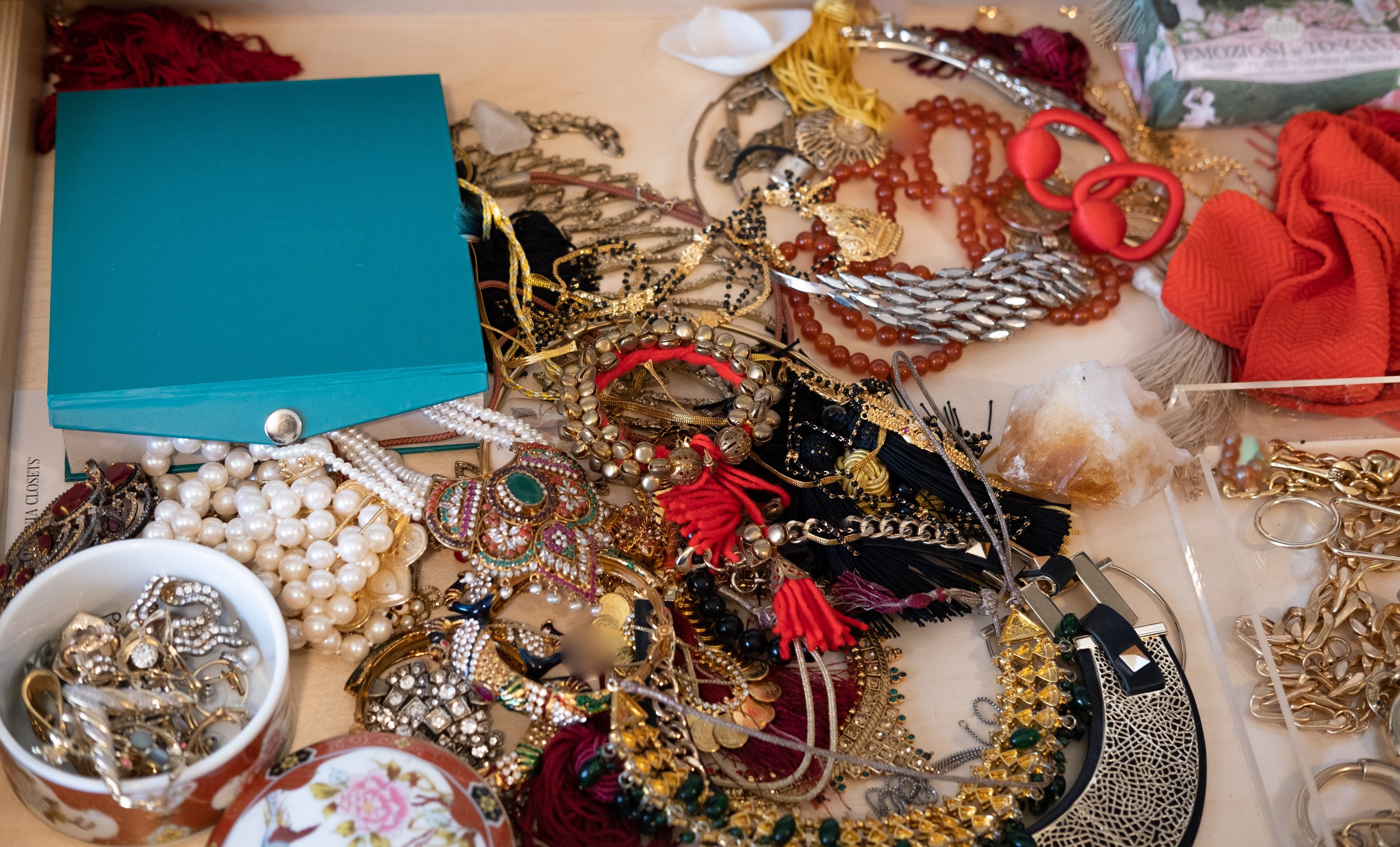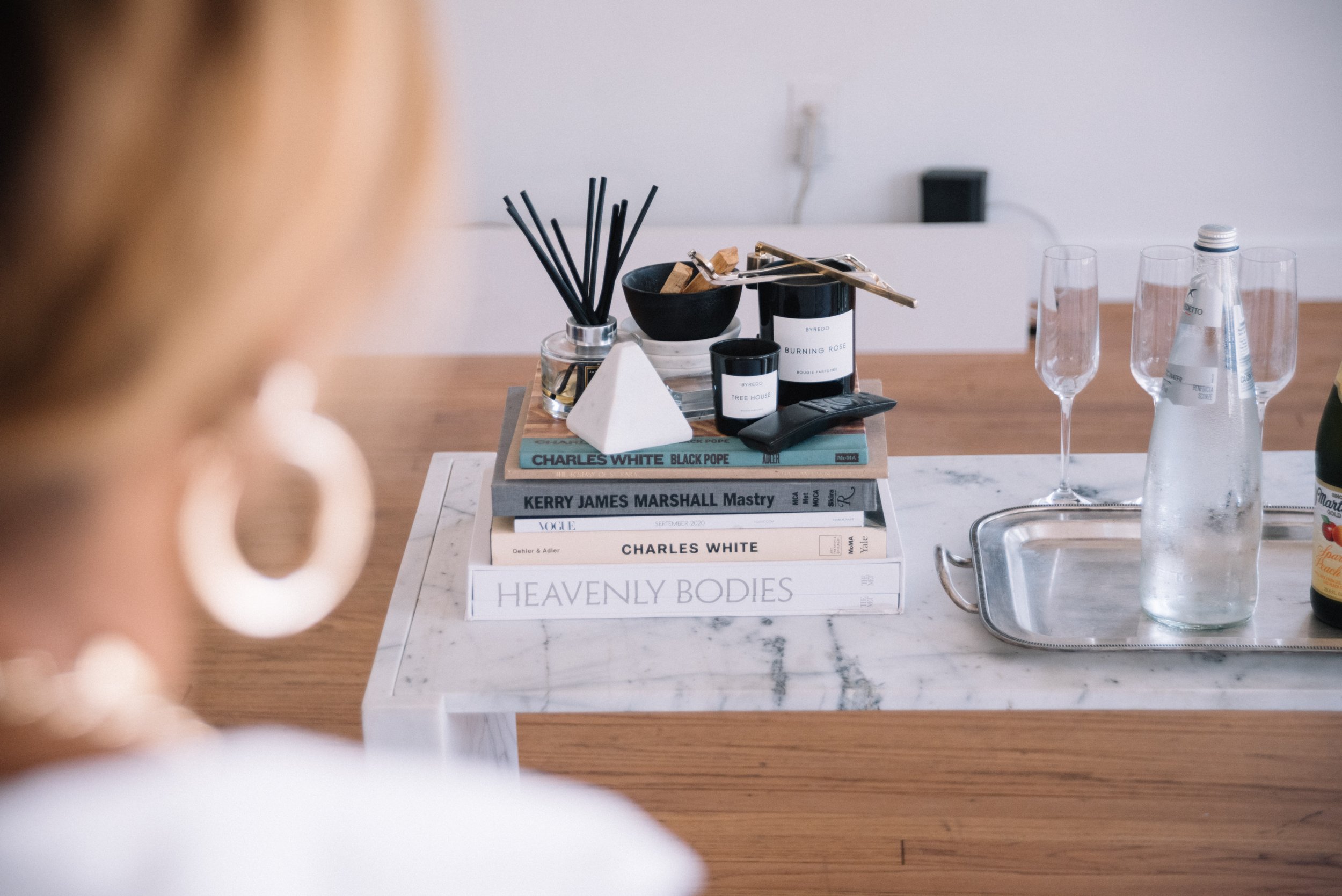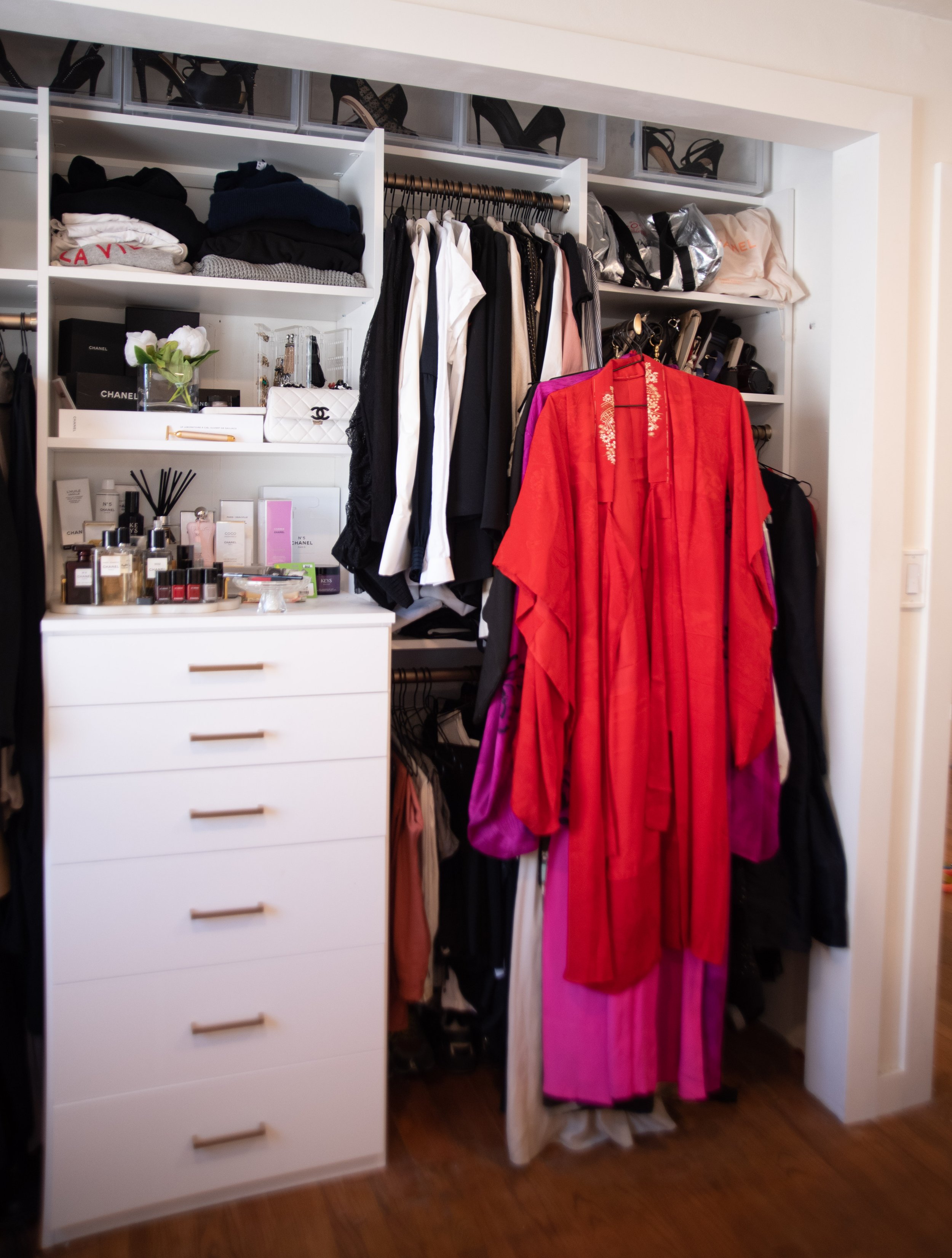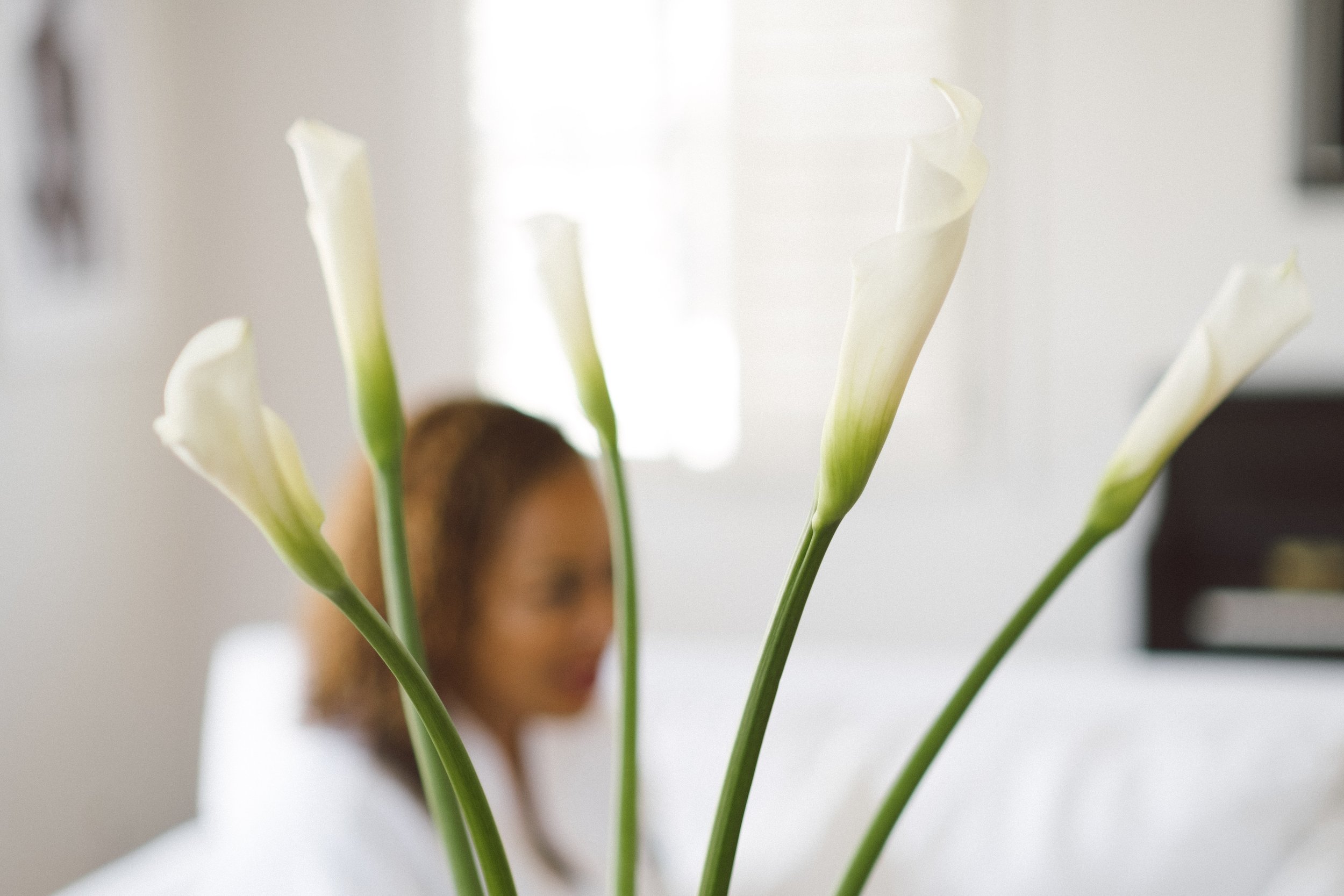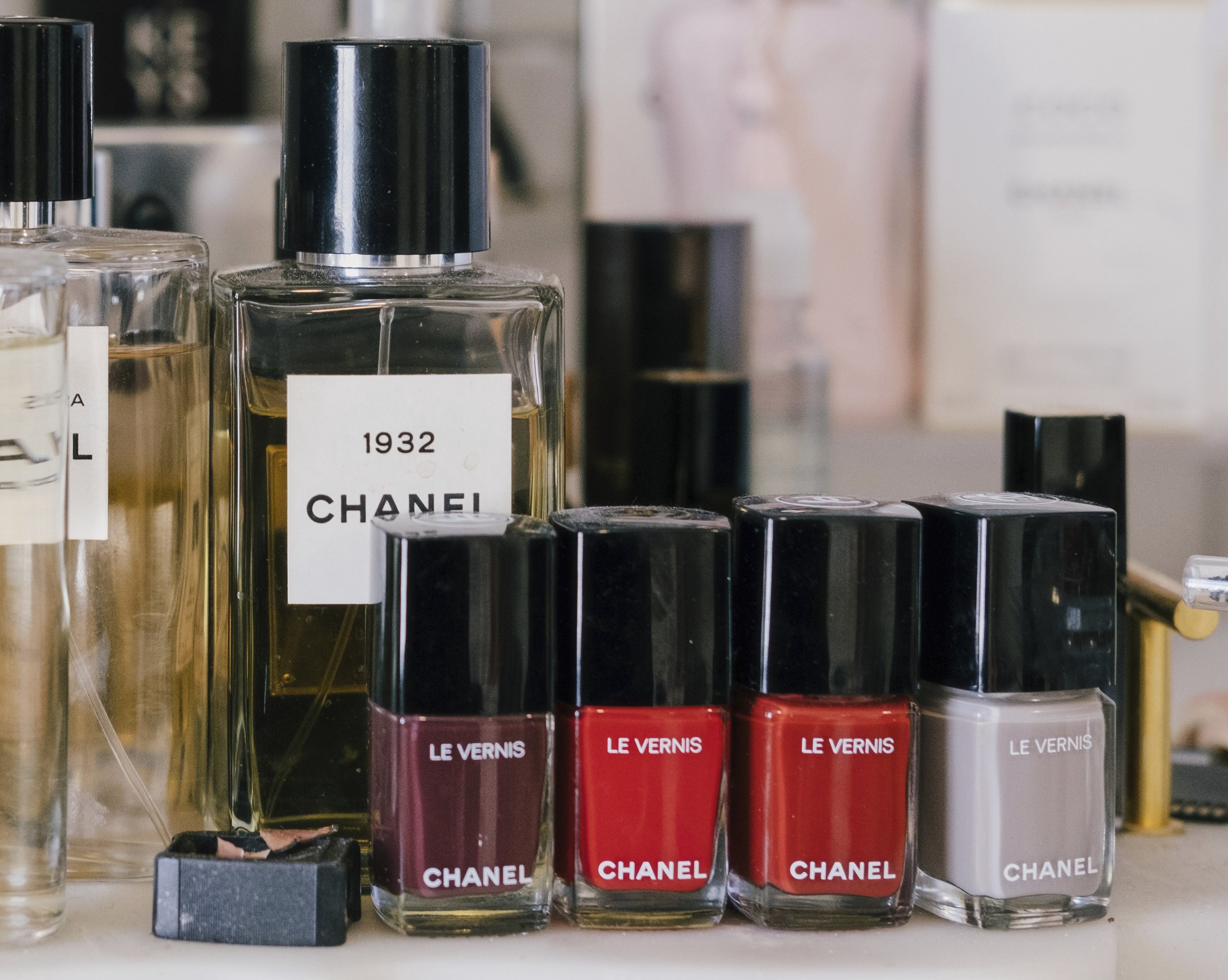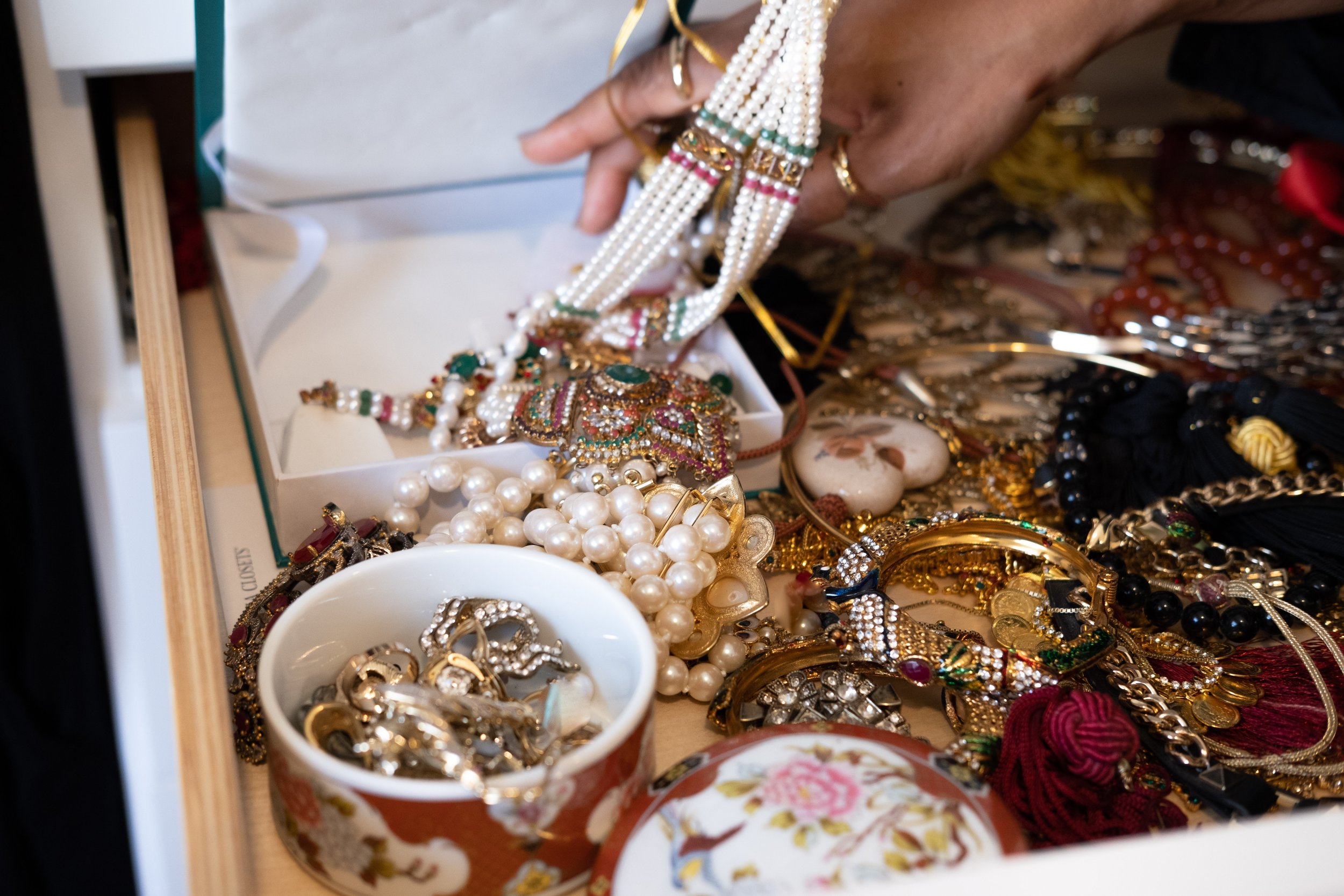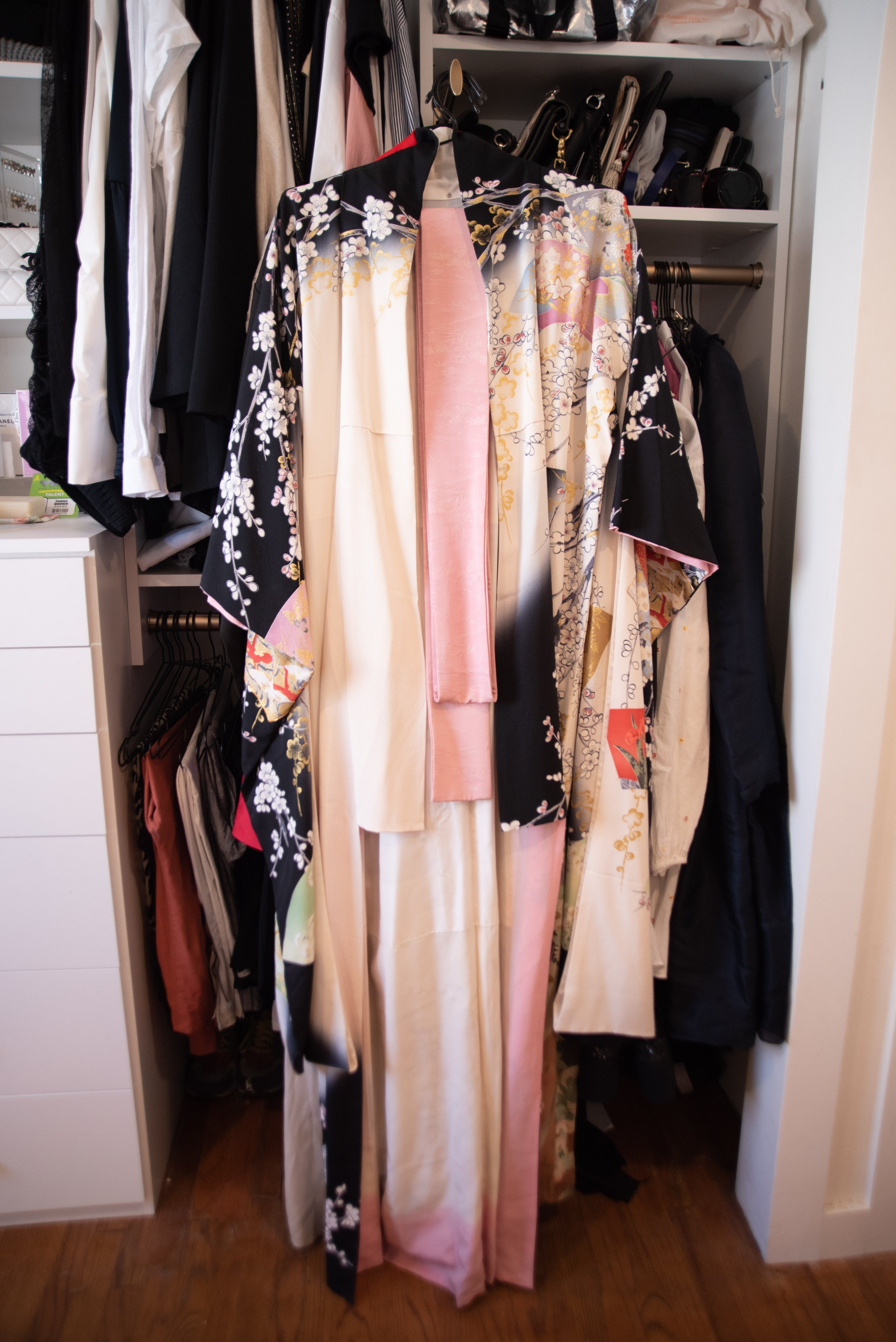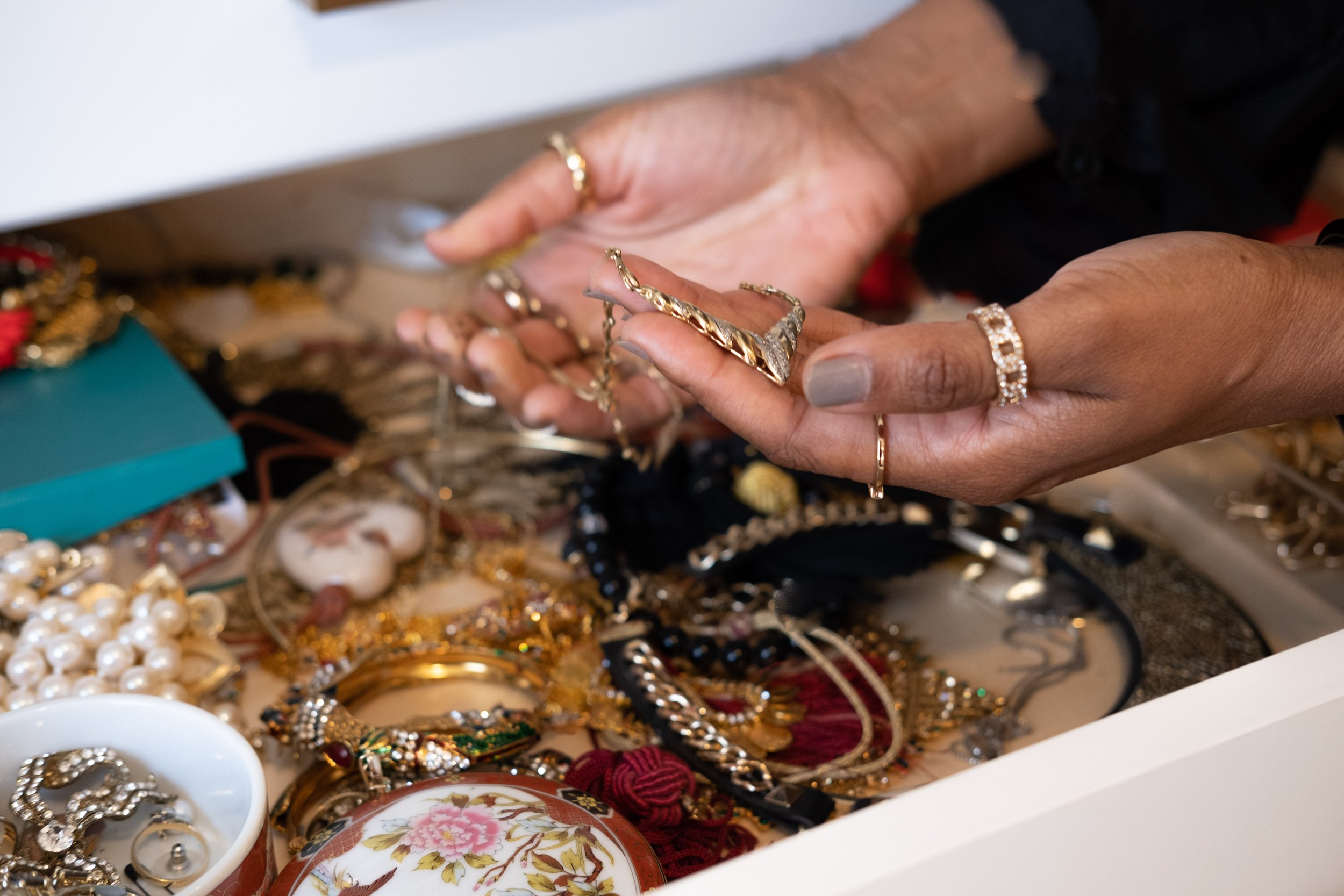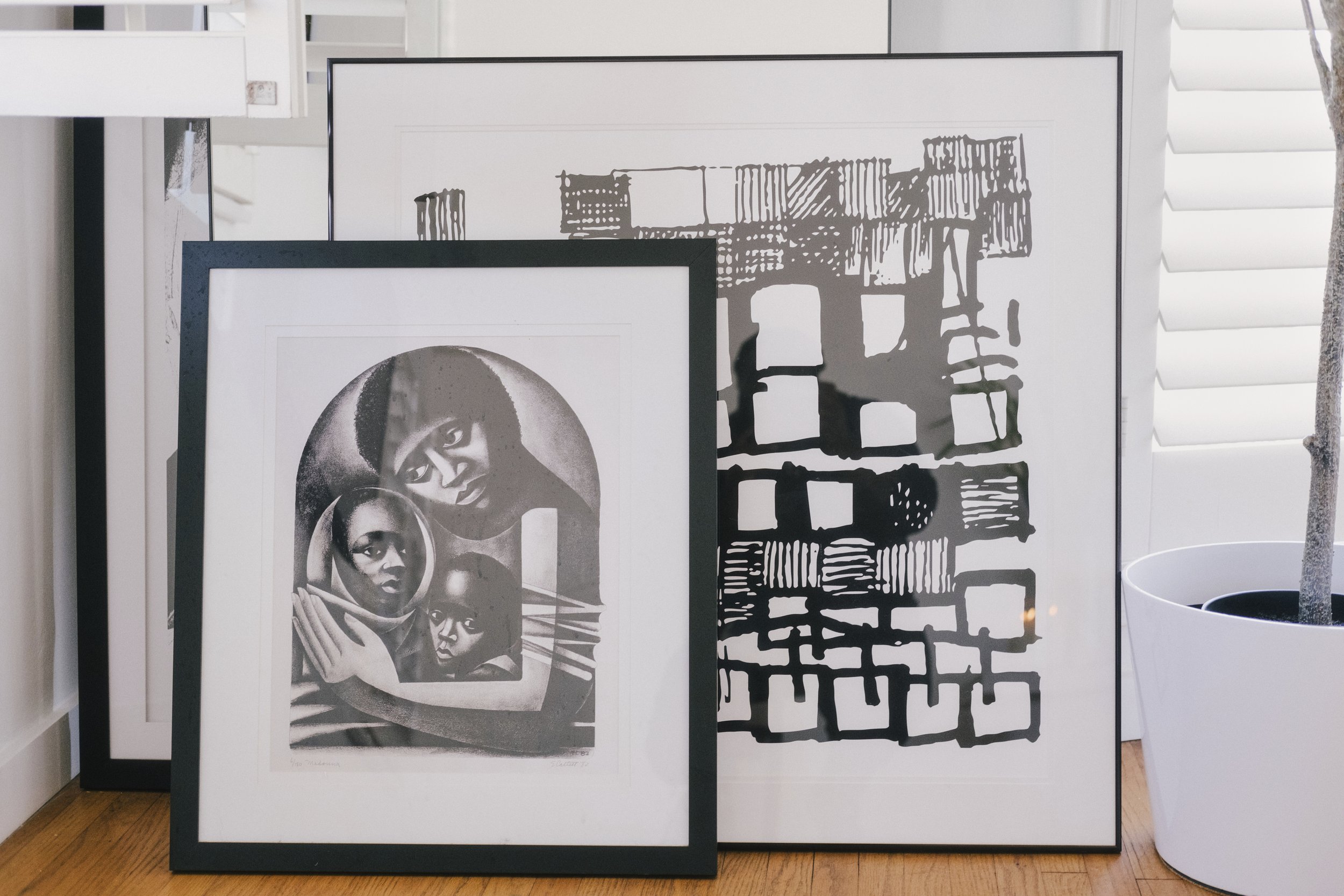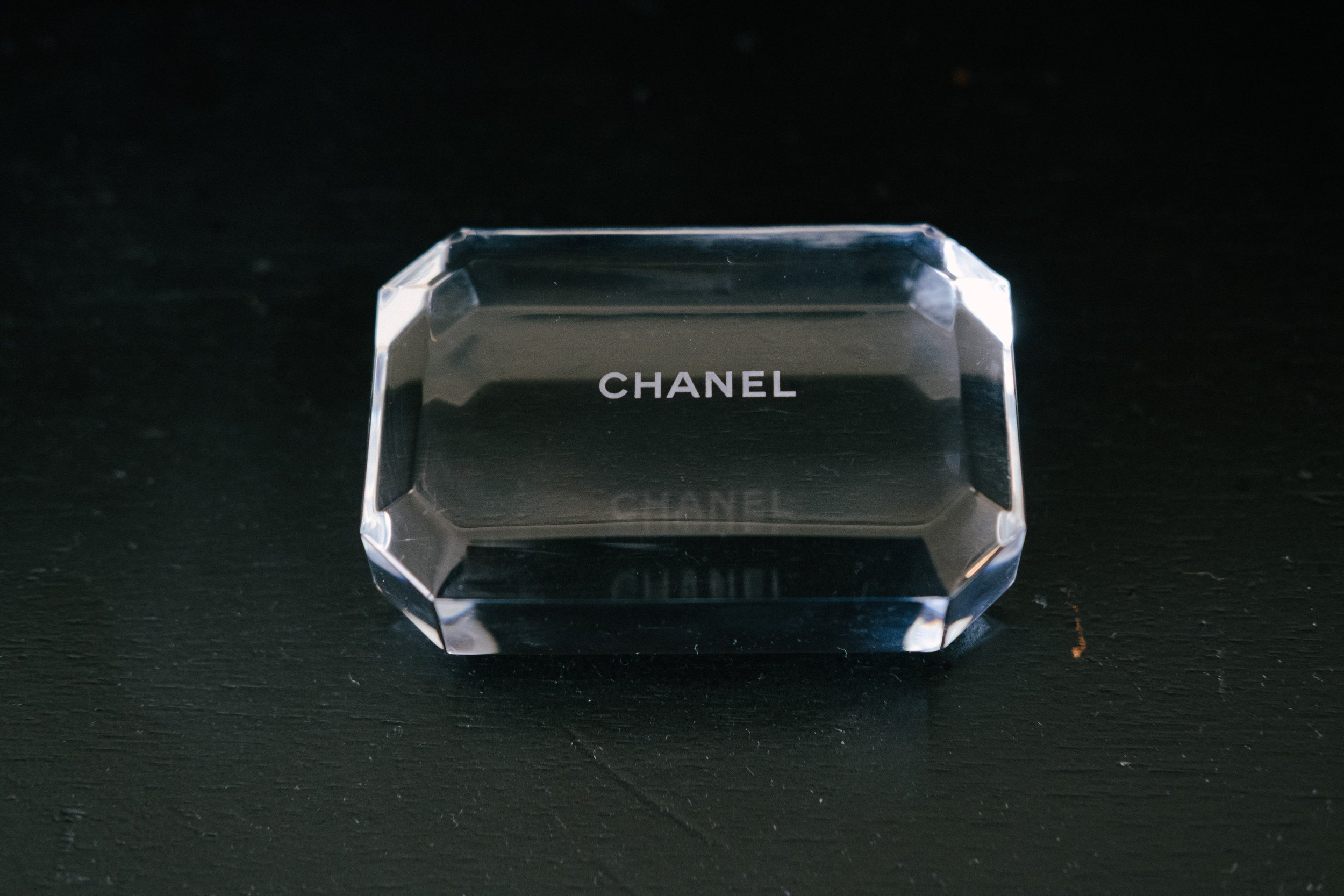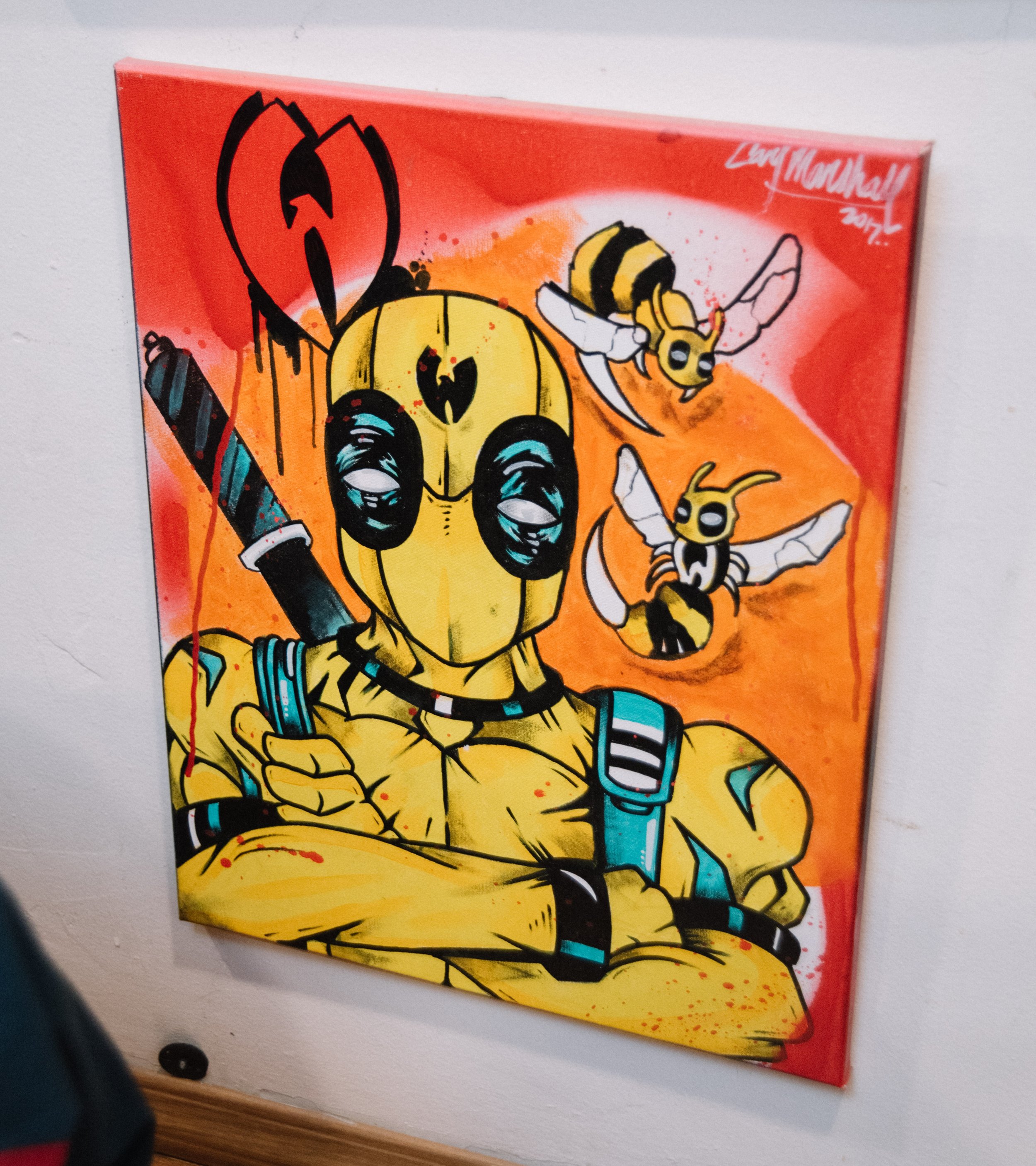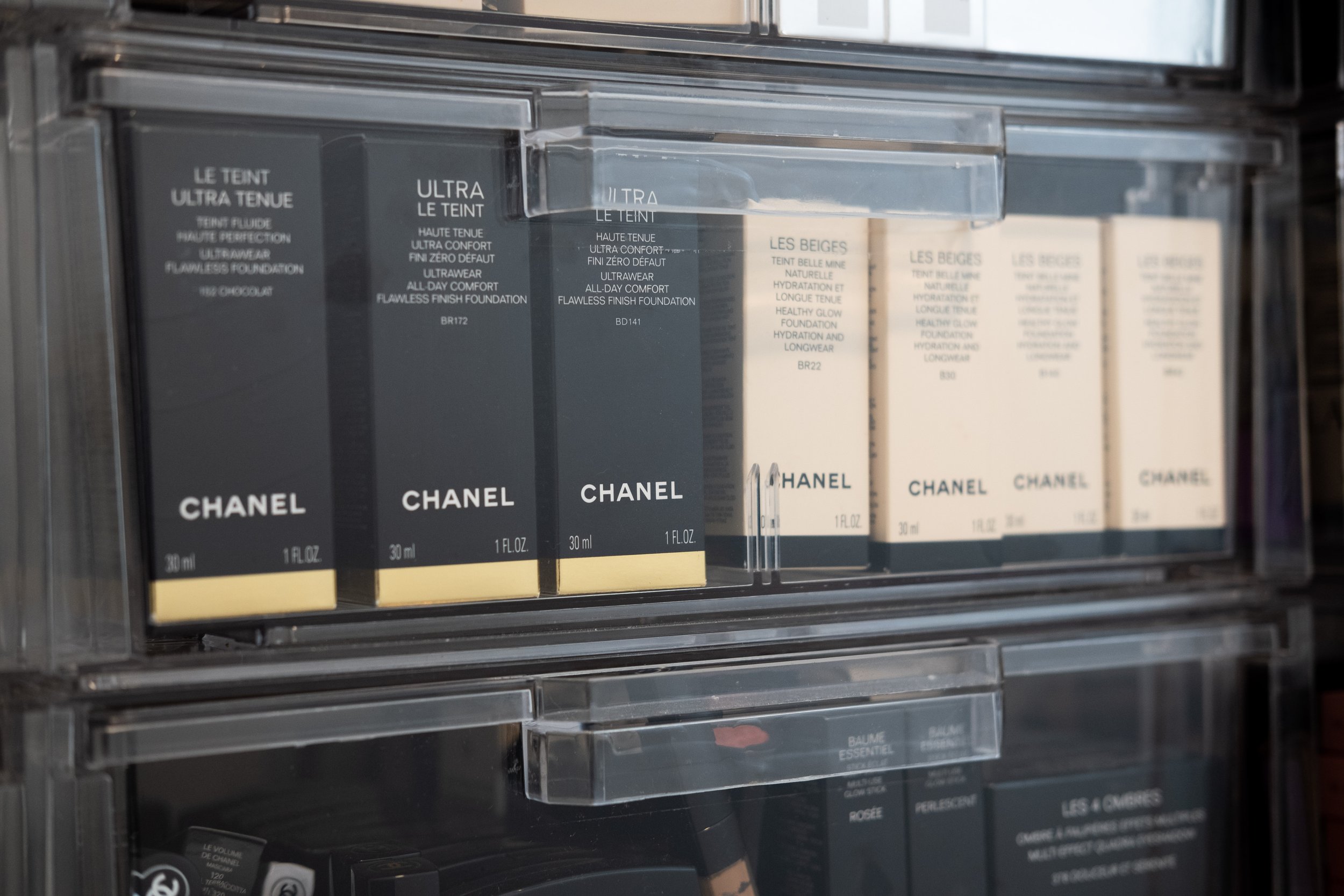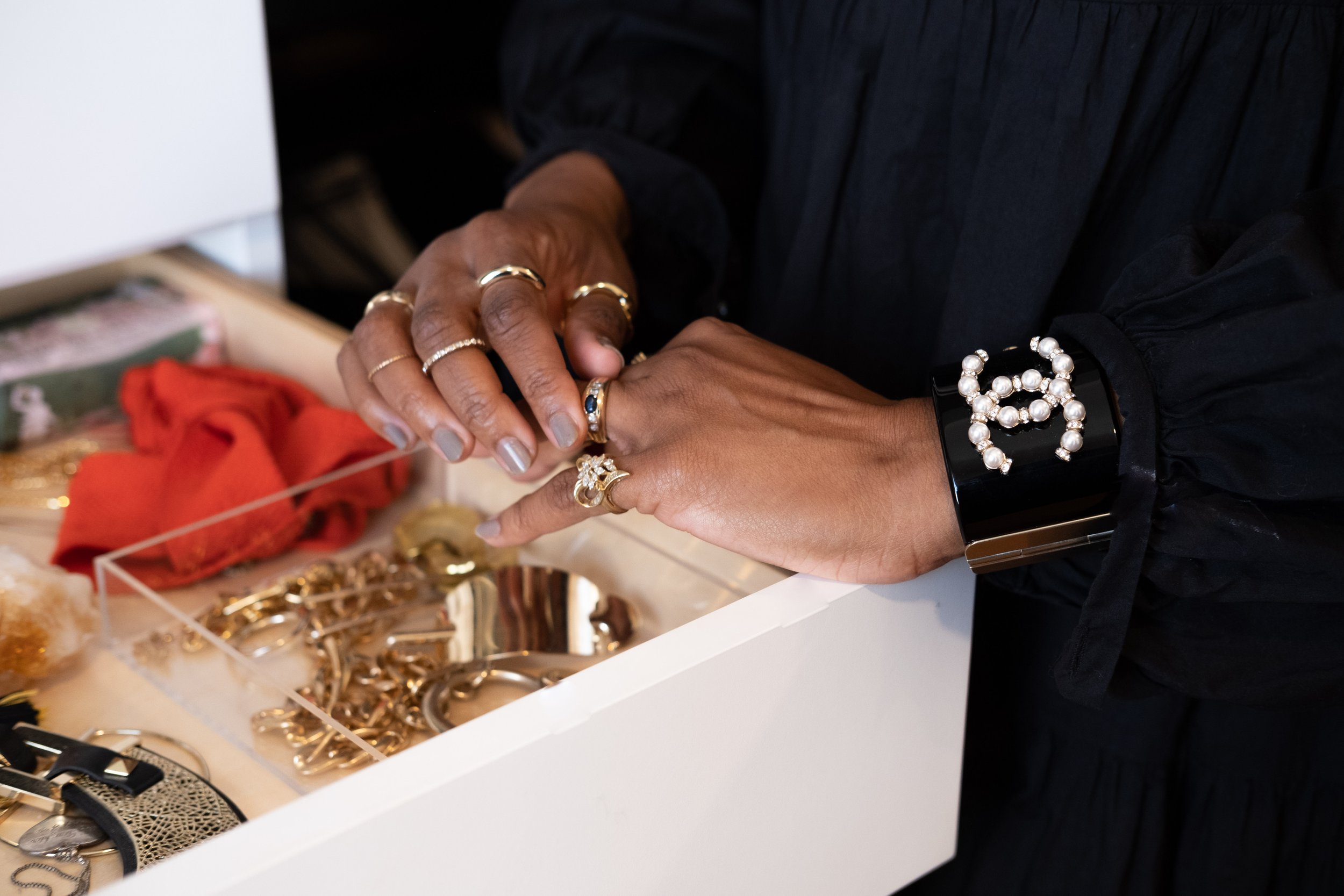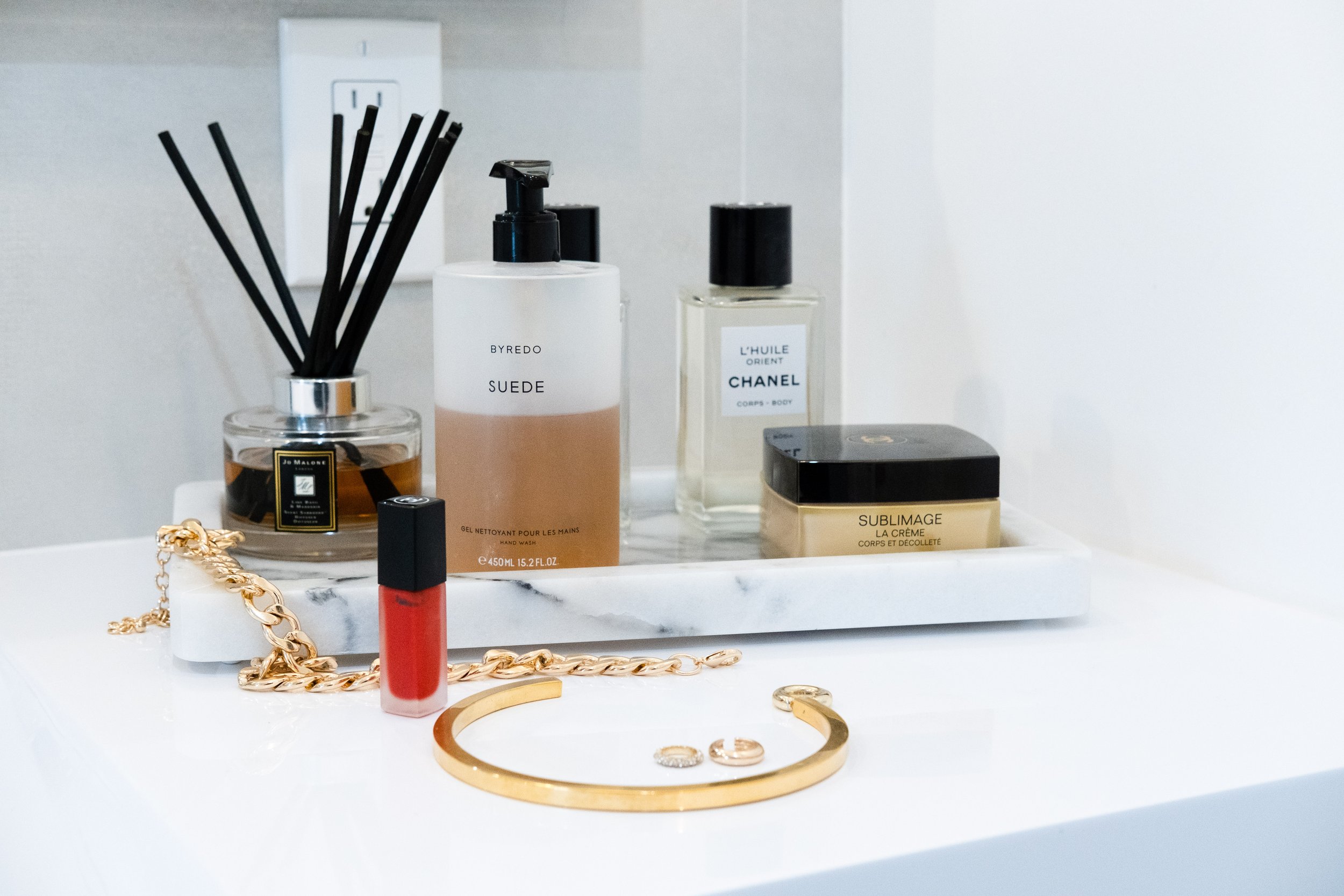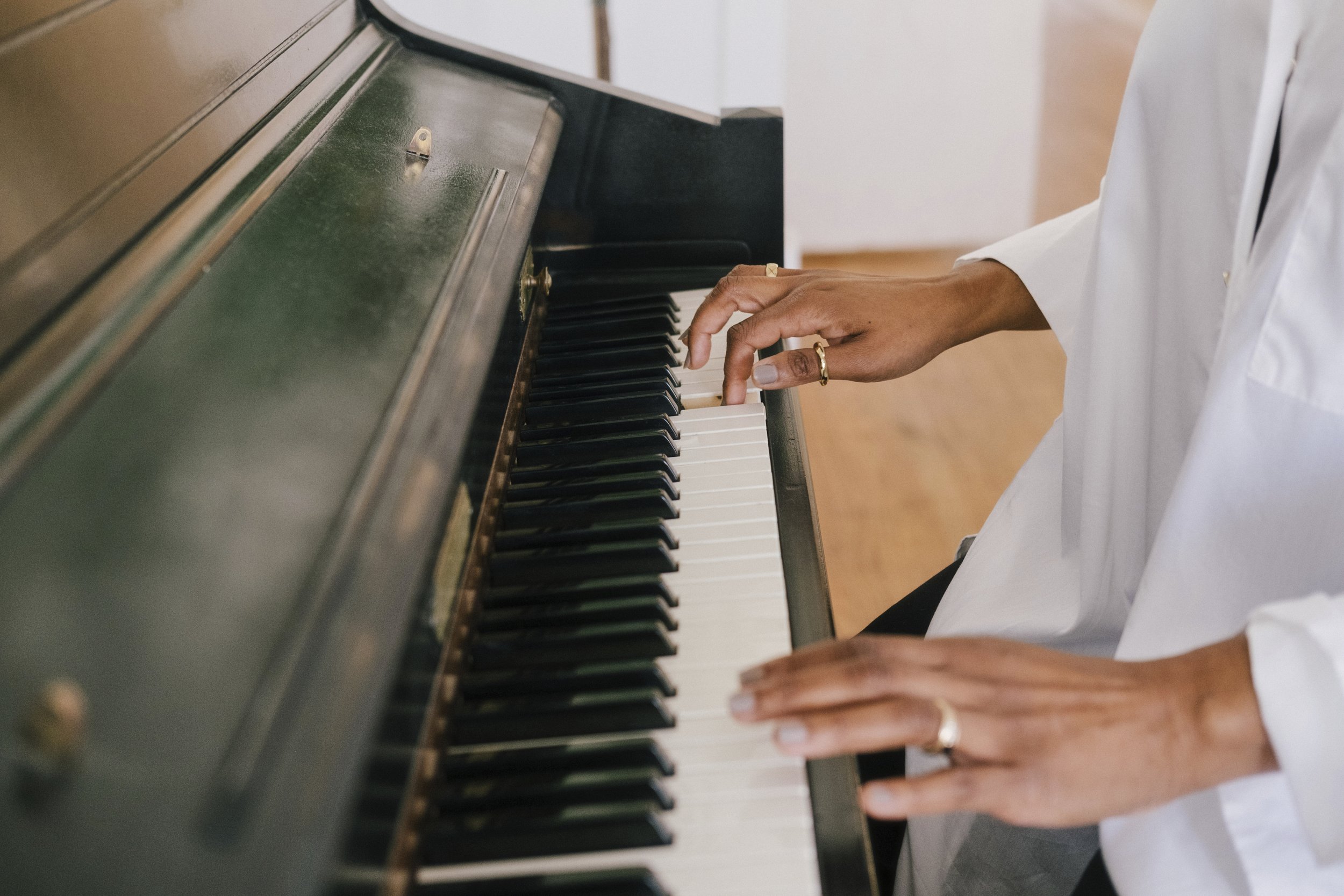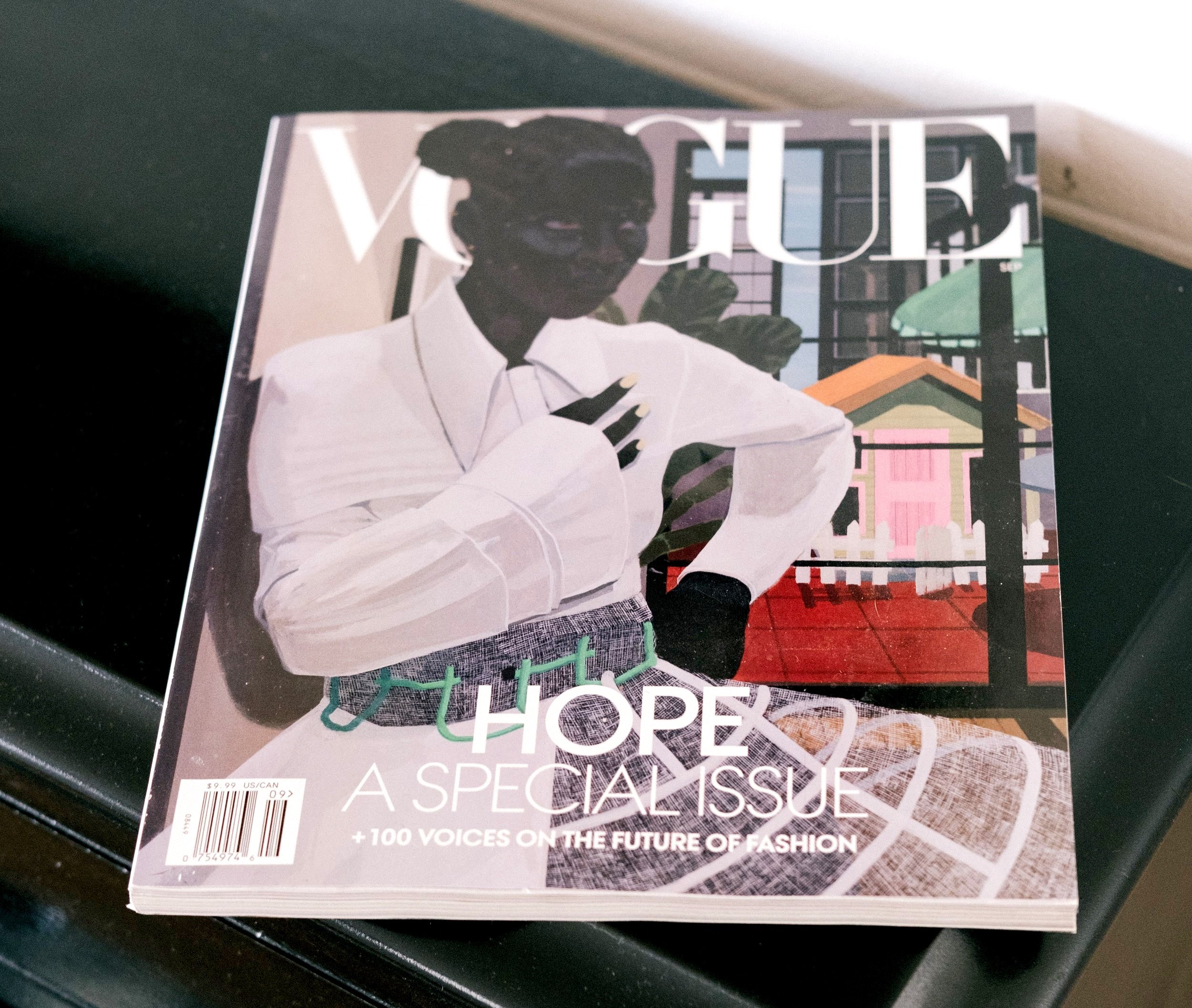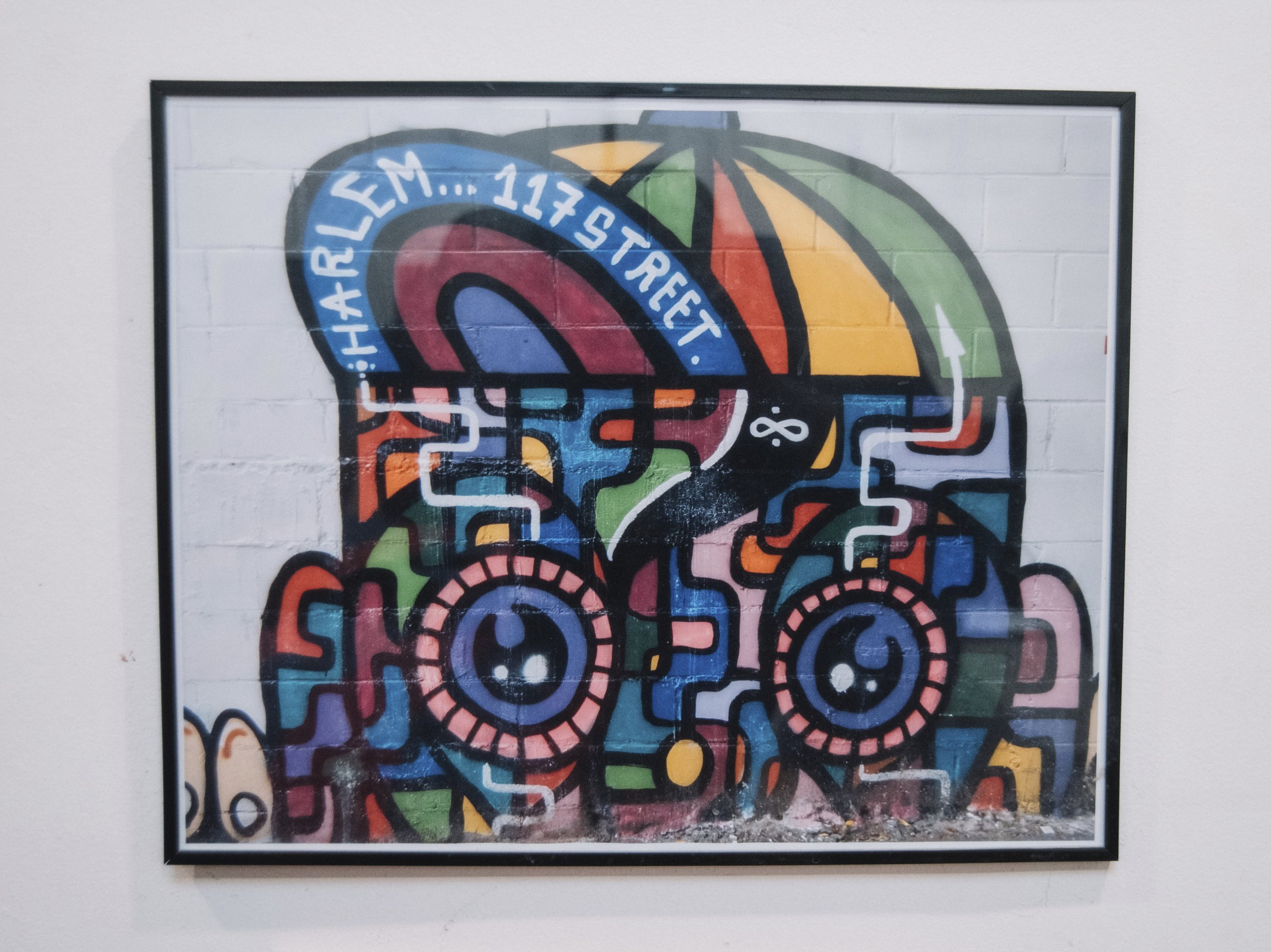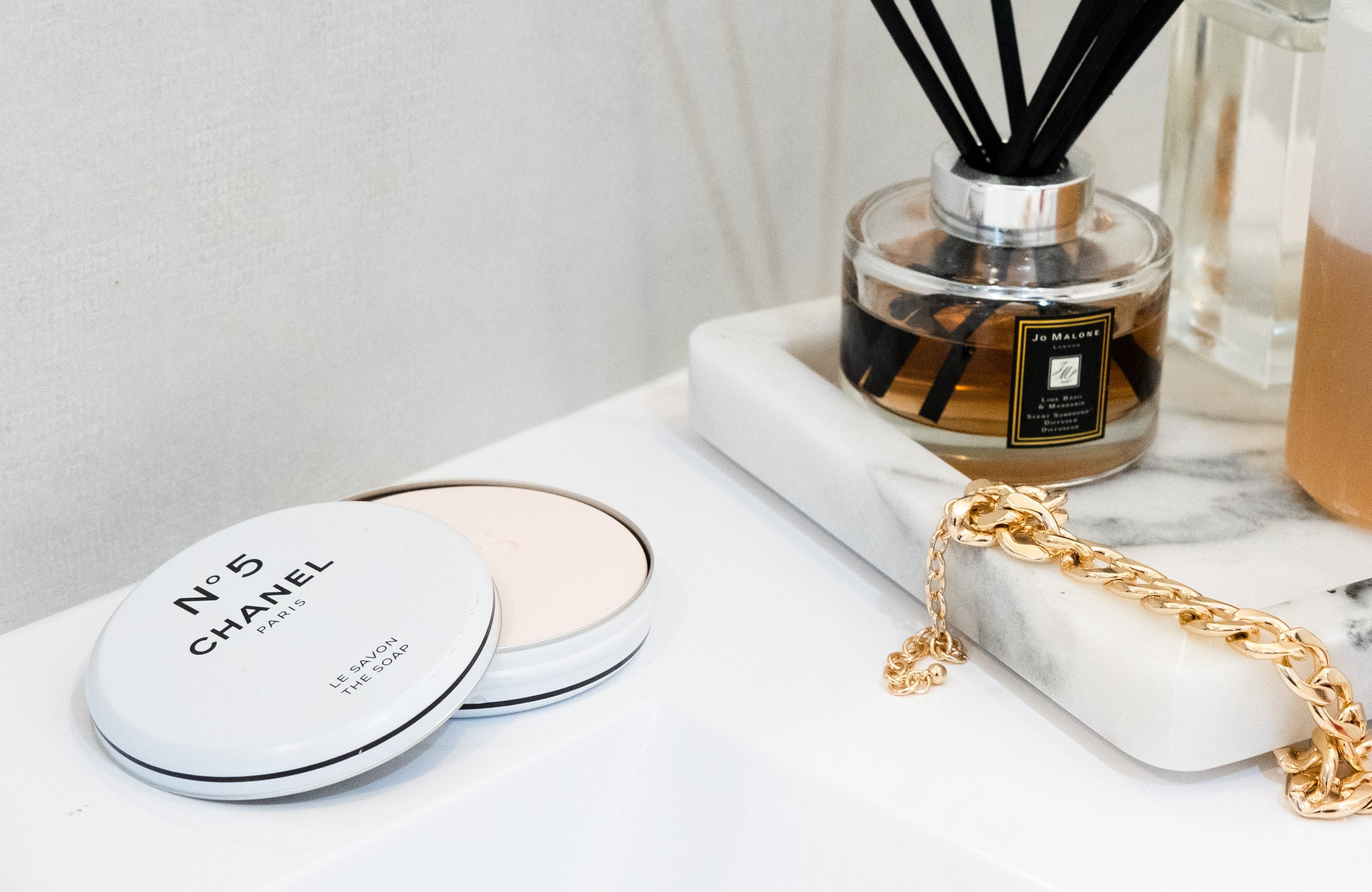Tasha Reiko Brown
The Chanel make-up artist and groomer discusses finding her passion and purpose after years on-the-go.
By Lindzi Scharf
Photography by Birdie Thompson
Celebrity make-up artist and groomer Tasha Reiko Brown has forged close bonds with nearly everyone she’s worked with – Tracee Ellis Ross, Gabrielle Union, Daniel Kaluuya, Chadwick Boseman, Alicia Keys, Jill Scott, and Lil Nas X. As a result, the Chanel ambassador has become as in-demand as the talent she works with – and yet, she doesn’t understand the sudden attention.
“What is so interesting about the girl two steps behind the talent?” she asks in earnest without an ounce of false humility.
Plenty – it turns out.
Born and raised in Los Angeles, the self-taught make-up artist – who dabbles in various artistic mediums including painting and interior design – got her start by talking her way backstage at a runway show during New York Fashion Week. From there, she worked with Stone Temple Pilots rocker Scott Weiland, toured the world with singer Jill Scott for four years, and collaborated with Florence Welch for two years before returning to her hometown. For much of that time, Brown lived what some might call a bohemian lifestyle that included creating graffiti art in Central Park and giving birth to her son Alex while on the road with musicians.
While her lifestyle and life story may sound glamorous from the outside looking in, Brown has no problem pointing out that appearances can be deceiving.
“It all sounds cool and romantic and chic,” Brown says, sipping coffee on a white couch in the living room of her Los Angeles home as jazz music plays in the background. She returned just a few hours earlier – having taken a red eye flight from Chicago after a job with Common.
“I don’t know if it’s because I’ve not been asked, but I’ve omitted struggle [from my story] because I didn’t attribute it either way,” she says. “The same way I don’t accept from people, ‘Oh, I’m this way because of this,’ as an excuse, I didn’t want people to use it as a barometer the other way.” Brown adds, “As much as I’m like a college entrance essay, like, ‘Tell us everything that went bad so we can praise you more for your success despite what you’ve endured,’ I’ve moved away from that narrative for so long. Not because of shame. Just because I was going to be good no matter what.”
But as Brown’s career has taken off and put her in a more forward-facing position, she now realizes the power in sharing the full extent of how she became the celebrated make-up artist she is today – with the hope that her experiences can inspire others. “I have no interest in crafting a perfect story,” she says. “By giving the totality of your life and putting in your struggles and everything you’ve gone through, there are so many more people on that side that you could help going through things. That is way more inspiring than the romanticism of it all.”
THE EARLY YEARS
Brown grew up painting. “I’ve always been an artist in a million different mediums,” she says, explaining that make-up entered the picture much later. While she often observed her grandmother applying lipstick and says she “loved the ritual of make-up,” it wasn’t until Brown’s teen years that she realized she’d found her calling.
“I wasn’t looking for this particular canvas when it found me,” she admits. “My younger sister was a model. She couldn’t drive, but I was seventeen and I’d just gotten my driver’s license. My mom had to work and was skeptical of the modeling industry, so she wanted someone grown to go with her.”
Brown continues, “I would take her to her jobs, but it’s not fascinating to watch your sister model. I’m sure everyone else on set was taken by her, but that was just my little sister. So I would burn time. I’d watch the artists work on her. I was like, ‘Ah. This feels like home.’ It clicked. I [thought], ‘I can do this as a living. There’s more to it than just what I’m seeing.’ When they were done with her, she was somebody else – and she moved differently. I saw up close the transformative power of make-up, and that was it.”
Brown immediately began promoting herself as a make-up artist. “I had a couple eye shadows and three foundations, so clearly I was a make-up artist,” she says with a laugh. “I was marketing myself as a make-up artist the next day.”
Eventually, the move paid off. “Somebody on-set told somebody who told somebody, ‘I know a make-up artist,’” Brown says. “I still remember my first paid job. It was in Pasadena. I thought I was [the legendary make-up artist] Pat McGrath that day. Do you remember the Cheesecake Factory menu where they had advertisements? A local boutique paid me to do their ad. ‘Vogue’ and Cheesecake Factory were the same thing to me at the time. It was published work as far as I was concerned. We celebrated. My mom went in the restaurant and stole the menu. She still has it somewhere. It was a big deal. I got $75 and I got paid to do something that I loved. Ever since then I’ve been able to make a living doing what I love and that’s the blessing of my life.”
In the early days, Brown admits her skillset was limited. “I had this one gold shadow and this one red shadow,” she remembers. “I called it a sunset eye and everybody got that sunset eye. It went from gold to burgundy.” Over time and with more experience under her belt, she branched out. “Being self-taught, it’s trial and error,” she admits, “and there is a lot of error. …. In the beginning, it was rough figuring out, ‘If it looks good [in person], how does it translate [on camera]? Which foundations will change on the skin?’ I learned a lot on-the-go.”
Brown moved to New York City at nineteen-years-old where she further pursued make-up. However, it wasn’t her passion that inspired the move. “I left [Los Angeles] because of a family situation,” she explains. “I left high school in eleventh grade. I [eventually] went to college, but I technically never finished high school. There were two whole years where I just could not go to school [because of a challenging circumstance I was navigating in my personal life]. I was essentially a drop out before I enrolled in college.”
She moved to Alphabet City in the East Village. “I was living that New York artist life,” Brown says. “I don’t even know where we got money.” She pauses. “I mean, we didn’t know where we were staying half the time,” she adds. “I was living with a bunch of artists. We were essentially like a homeless band of roving artists where we’d go from place to place – whoever had an empty [room or couch].”
Despite not having any connections in the fashion or beauty industry, Brown was determined to pursue her passion. “In Hell’s Kitchen, there were a couple of drag shows,” she says. “I would go and they would pay you to clean up their make-up and do their lashes, so I got $35 cash off each performer. You couldn’t do it from scratch. They did their own make-up, but you could hang around and fix things.”
Eventually, through word of mouth, Brown heard about what she calls an “off, off, very, very, far off New York Fashion Week show” where she managed to slip backstage. “Back then, you could sneak in,” she says. “I somehow knew a name to drop. Now with security and badges, you can’t. We know the exact teams, certain make-up brands are sponsoring it; it’s a different world now, but back then, models still smoked backstage and it was more of a party.”
She continues, “I was backstage and [told people], ‘I’m one of the make-up artists.’ They’re like, ‘Clearly, you are not,’ but I took a chance and would clean brushes [for the actual make-up artists]. I didn’t even know how to [properly] clean brushes, but I figured it out and then the next show, I [asked], ‘Can I keep cleaning? Do you have somebody?’ That ended up being the thing [that got me in the door].”
LA VIE BOHEME
While Brown pursued her dream by day, she would often do graffiti in Central Park at night. “If you have nowhere to sleep…” she says, pausing without completing the thought. “You can sleep in Central Park in the daytime because it’s lovely. It’s like, ‘Look at them. They’re picnicking and having a little [siesta].’ But if you do it at night, it’s dangerous. So at night, you have to occupy yourself and you do what you love because you sleep during the day. It’s a little bit like rockstar life, you know? You sleep all day and then you paint and party all night. Someone’s got something going on at the after-hours. You go there and then you graffiti until the sun comes up.”
Looking back, she admits, “It’s dangerous, but at the time, it was the best time of my life. Even though it was a time filled with so much struggle and uncertainty, it was the ignorance of youth. I look back and think, ‘Those are still the greatest times of my life. Climbing a building. Graffiti-ing and watching the city come alive. That moment where it’s quiet and the city is a low rumble and then right around eight o’clock everyone leaves their home and the sun is all the way up. It’s like a crescendo and you’re creating.’ When you’re in that space, you connect to a higher power and a certain energy.”
Eventually, Brown got caught doing graffiti on public property, which landed on her permanent record. “[People ask,] ‘How did they catch you? Didn’t you see them coming?’” she says. “No. Not really. I was in the zone. Until they tap you on the shoulder and you have the can in hand, you get lost. I still do that when I’m painting faces.”
All the while, Brown never lost track of her professional goal. “The blessing of my life is that I was born with this sense of entitlement – not like a bratty sense of entitlement where I feel like I deserve something for no reason,” she says. “But [the idea that], ‘That’s not good enough for me. Statistics don’t apply to me.’ I always felt like I could do anything and everything. There was nothing in my brain that said, ‘You can’t achieve that.’ Even if someone was like, ‘You can’t.’ Yes, I could. Because I’ve got hustle. I will figure out a way. There’s nothing I can’t do.”
Through word of mouth, one job led to another and Brown eventually found herself assisting runway make-up artists backstage at New York Fashion Week. “I ended up working all these shows—like Betsey Johnson—where the make-up was bigger than me at the time,” she remembers. “I did not have the skillset to do that at all, but I could assist and I could learn.” She worked with the likes of Tom Pecheux on a Tommy Hilfiger shoot with photographer Peter Lindbergh, Mark Carrasquillo on Avon campaigns with Salma Hayek, and Pat McGrath as part of a larger team. “I learned a lot by watching,” Brown says. “I’m a quick study.”
Brown’s big break arrived in the form of an overheard conversation backstage at one of the New York runway shows. “A model said her boyfriend needed make-up for a shoot,” she recalls. “It wasn’t called grooming then. Grooming is very much a new term; so they said, ‘He needs make-up. He’s doing this shoot.’ Of course, it was a model – so her boyfriend was a rocker.” She laughs. “I quickly learned [that with rockstars], ‘You don’t even need powder. All you need is eyeliner. Just have eyeliner and, sometimes, this white pancake base – if they want to look a little weird.’” Brown completed the job. “Then the photographer was shooting somebody else the next day and it was Stone Temple Pilots. I ended up working with Scott Weiland for quite some time.”
MUSICIANS & MOTHERHOOD
By twenty-one, Brown moved back to Los Angeles – where she shifted focus to celebrity, but more specifically, rockers. “I did shoots with Ross Halfin who is this legendary rock photographer,” she says. “I worked on a lot of ‘Guitar World’ magazine covers,” through which she met iconic musicians like Lindsey Buckingham and Slash. “If they held a guitar I pretty much worked with them at some point,” she jokes. “I think they liked me because I didn’t know who they were. I’m the girl who asked [Jimmy Page of Led Zeppelin], ‘Oh, so you play guitar?’ He [said], ‘Yeah. Sometimes.’ I was like, ‘That’s cool. You ever been to Los Angeles before?’ He [said], ‘First time sober here.’”
From there, Brown began touring the country with various plays and musical acts including Nickelodeon’s live tours based on their cartoons. “You’re in all of these amazing cities,” she says, reflecting on that era.
Eventually, however, the pace took its toll. “Life on the road is hard on your body,” she says. “After the show, by the time you get out of there, there’s a meet and greet. Say you leave at 12:30 in the morning. What’s open? We’re not in L.A. We’re talking Idaho. It’s fast food. …. You’re never eating right. Your metabolism and sleep pattern is hell. You get off the bus and then you catch a flight. Lucky for me, it trained me for what I’m doing now.”
Even so, Brown realized she needed to make a change once her son Alex entered the picture.
Being pregnant on the road proved to be especially difficult. “My diet was crap,” Brown reflects. “I went from eating whatever I could afford in New York to eating whatever [was available while traveling]. It was catered, but it was still crap. The doctor put me on bed rest because I gained a massive amount of weight.”
She took his advice and moved back to Los Angeles. “I had to adjust my entire life from the moment he was born,” she says. “When you’re an artist, you are selfish. I had to change, but it wasn’t begrudgingly. It was all for the better. …. Motherhood is the best.” She pauses, then gets serious: “Let’s be clear. I hated being pregnant. Women [will say], ‘I was glowing. It was magical.’ No. I was miserable pregnant, but being a mom [is a different story].”
That’s not to say it’s been easy. For the first few months of her son Alex’s life, Brown stuck to working with talent locally; but she recalls: “I was so exhausted. I remember looking at him when he was three months old and I [said], ‘Listen, it’s just me and you. If we’re going to make it, you have to sleep through the night. I swear to you, I will do whatever I need to do to feed and house us, but boy, I need you to go to sleep because if I have a full eight hours of sleep, I can rule the world. Trust me. I’ve made nothing out of something my entire life, but I had sleep – and you are messing with that program.’ I promise you, two days later, he slept through the night. He was like, ‘Oh, no. We want success.’” She laughs. “After making those adjustments, he’s been easy.”
In 2011, Brown booked what was meant to be a one-off job for singer Jill Scott. “Somehow I landed in Jill Scott’s living room,” Brown says. “She smiled at me and a Jill Scott smile is like standing in the sun. The whole room gets brighter.” The two bonded and the next thing Brown knew she had a job offer. “[Jill] was like, ‘What do you have coming up? Would you like to go on tour with me?’”
Brown traveled with Scott for four years. “That was one of the great blessings of my life,” she says, explaining she found a way to resume her unconventional work schedule while raising her son.
“I’ve taken him everywhere,” Brown says. “He ended up touring with me. He grew up backstage in Jill’s dressing room; so he’s a child of the road.” When her son would ask why they were traveling so much, she remembers telling him, “‘We’re on the road because mommy’s painting something and yes, it’s a lady’s face, but it’s art.’”
She kept her son busy with books and would take him to museums. She also tried to create routines for him and a certain level of consistency. “When we went to New York, we had the same hotel room in the same hotel,” she says. “At museums, I would have him read the plaques. You have to be creative.”
Eventually, the duo returned to their home base of Los Angeles. “I had to stop touring because my son got older,” she says. “They were like, ‘Um, he actually does have to go to school. We’re paying attention. His absences aren’t adorable anymore.’” Her son is now fifteen-years-old. “I still pull him out of school to go traveling, but he has good grades. It’s fine. I want him to learn about the world. He can learn what’s in books, but he likes learning about the world, so he gets a little bit of both. That’s what works for us.”
When her son was still a child, Brown admits she felt insecure about what some might consider an unconventional upbringing. “I’m much more secure now, but I was such an insecure mom,” she admits. “People would ask, ‘When does he go to school?’ That would really get to me. I’ve always been a single mom, so it felt like, even when people weren’t [actually] judging, everything felt like judging. It was my sore spot. But now, having grown, I realize, ‘If I’m doing something that’s aligning with my passion and purpose, I know it has his best interest at heart.’ So judgment means nothing, but it took a while to grow into that. …. [People say,] ‘Children need a schedule.’ Do they? Or do your children need a schedule? If no schedule is our schedule, it’s still a schedule.”
As her son got older, Brown was able to step away for work more easily, but she says motherhood changed her perspective and put an even greater emphasis on her passion for what she does. “I don’t leave my son at home to be mediocre,” she says. “He’s so important to me that if you see me throwing a fit because, ‘This is the color lipstick and I know it’s the color [to choose],’ – and you’re like, ‘It’s just lipstick.’ No, it isn’t. If I’m going to spend time away from my son, I want him to know it is because I went out there and I did something that aligned with my passion and purpose.’”
She credits Scott with teaching her that outlook and says the singer helped her grow both personally and professionally. “She is one of the miracles of my life,” Brown says. “She is an artist’s artist. If you work with Jill Scott and you don’t come out of that experience being a completely different artist, I humbly say, ‘You have wasted your time and hers.’ …. When you see her sing something, know one hundred percent that she’s not singing it – she is actually going through that emotion on stage. That’s what I learned from her. When people are like, ‘It’s just a red lip.’ No. It’s not just a red lip. It is all passion and purpose.”
THE LAST HANDFUL OF YEARS
In recent years, Brown expanded her client base beyond musicians. “When you work with musicians, you’re either with them or you’re not,” she explains. “They go long periods without albums. I thought, ‘I live in L.A. I’m not going to do a ton of campaign shoots or runway shows here, but I can go to Erewhon and run into a celebrity,’ so I started working with celebrities.”
While the schedule and pace is slightly different, Brown insists it’s roughly the same job. “It was a natural transition,” she says. “I float in and out all the time. I’ll do Alicia [Keys]’s music video and the next day, I’m doing press for a film with an actor. It’s the same canvas—skin. Swapping between industries is easy.”
However, the last few years have been anything but easy for Brown – due to the pandemic, our country’s racial reckoning, and the loss of Brown’s client Chadwick Boseman, who passed away of colon cancer on August 28, 2020.
“It’s been hell,” Brown says. “It’s been highly challenging in a million different ways. I’m still processing it. It was a lot of grieving. Chadwick passed in the middle of the pandemic and that was just…” She struggles to find the right words. “The grieving…” She stops, then buttons the thought: “I was grieving silently.”
Around the same time, her mother was diagnosed with Alzheimer’s. “Because of the pandemic, I couldn’t see her [even though she lives relatively close in California]; I didn’t want to get her sick,” Brown says. “She was being passed the phone and she was doing pleasantries. Then I realized, ‘She has no idea who I am,’ and there’s no way to catch that moment: ‘When was the last time where she knew who I was?’ You can’t go back. I lost that.”
As difficult as 2020 and 2021 proved to be, Brown found solace in exploring new forms of creativity. She refurbished a piano; she painted her house; she redesigned the bathroom; she began construction on her kitchen, backyard, pool, and front yard. “After two months in, I realized, ‘There’s nothing left,’” she says. “I thought, ‘Lady, no one wants to see you put on a red lip for the nine billionth time in your house.’ I’m the most boring canvas to myself.”
She used the unexpected downtime to reconnect with herself. “I was so busy before the pandemic,” she reflects. “I was on a good nine month run. [During the downtime,] I realized, ‘There is a lot more to me than just [what I do for a living],’ because art is not separate in my life. Art is at home. Art is in my son’s room. Art is in the hallway. I don’t like my make-up put away where I can’t see it. I like to connect with it every day. Art is all the time. So I felt like, ‘If I’m not in art, around art, creating art: who am I – honestly?’”
She says for the first time in years, she contemplated, “What do you like? What do you do? If it’s just traveling and eating – those things can easily go away.”
Brown then vacillates between speaking as herself and verbalizing her inner dialogue. “I told myself, ‘Dig deeper. There has to be more. You sound like a Bumble bio: I like travel and art. Connect to something higher; connect to something lower. Find something else.’”
Brown also used the time to bond with her son. “He finally had to hang with me because it was a global pandemic,” she says. “That’s what it took.” While they used to travel together all the time, she explains he’s at that age where he typically, and understandably, spends much more time with his high school buddies. “I missed us—the us that hung out twenty-four hours day. I knew it was going to go away because he’s a teenager now, but it was that last grasp—just me and you.”
Over time, work picked back up as the fashion, beauty, and entertainment industries rebounded and found a way to operate within the world’s ever-changing new normal.
On December 11, 2020, Brown was named Chanel’s first male groomer in addition to working as a make-up artist and ambassador for the luxury label. “When I was thinking of partnering with a brand, Chanel made the most sense because they’re about the art,” she says, sharing she’s been wearing Chanel since 1987. “Chanel was the obvious choice because I like pigment. I like things that work. I like classics. I like an elegant texture. The product very much speaks to my style. I wouldn’t partner with a brand if I couldn’t be a consumer of theirs, so [the opportunity] hit the mark a hundred different ways.”
Brown says that Chanel has been supportive of her and her career – long before she had a social media following or high-profile clients. “Elizabeth [Riley Fraise, Chanel’s executive director] has always supported me – way before I had a blue check mark next to my name [on Instagram],” she says. “She supported me for projects where I couldn’t get support from other brands. She supported me with a client who wasn’t a huge name [at the time], an actress going to an awards show that wasn’t even televised. Now they’re a huge name, but Chanel looks at art. It’s about what you create. They appreciated my art and that was important to me.”
As the event and editorial world picked back up, Brown found herself everywhere from photo shoots with Michael B. Jordan to the Met Gala in New York with Alicia Keys – thanks to daily testing, vaccines, and COVID protocols that were put in place. Brown feels grateful to be busy again and shrugs it off when asked how she keeps up with the hectic pace required of her profession.
“People are always like, ‘How are you getting through it all?’” she says. “But I’m so busy getting through it all that I don’t notice. But that’s any mom, like, ‘How do you do it?’ I’ll tell you when I’m done doing it.” She laughs, then notes that her current schedule pales in comparison to her past experiences living life on the road. “This absolutely nothing to me,” she says. “Anybody else at my grown age would be exhausted whereas I can go for two whole weeks because I’ve trained. That’s how I know I’m where I’m supposed to be because everything lines up. Even now, I just got back from Chicago a couple of hours ago. I flew in on a redeye after two jobs. I had a lovely room at the Waldorf Astoria for a whole forty-five minutes, but it’s different than a tour bus.”
THE JOB
Brown acknowledges there are a lot of misconceptions about her job. “It is glamorous,” she says, “but it is not glamorous for you. You do not have an album coming out. You are in glamorous settings, but you are at work. I’ve been backstage at the Oscars, looking out at the front row, and then had to sit on a little rickety stool. I was carrying a ninety-pound bag [full of make-up]. It’s a job.”
She says her profession’s reality can be lost in translation due to Instagram – and that, occasionally, even colleagues can get caught up in social media culture. “If it stops being about the work and it starts being about the glamorous moments, [there’s a problem],” she says. “I’ve seen it affect so many people. That’s not what it is about. Put your head down; do the work; enjoy what you do; enjoy the glamorous moments, but don’t become that. Have a life outside of this. Make sure this serves you in another way other than fabulousness.”
Brown adds, “I see a lot of younger artists where they’re doing things and I’m like, ‘You did it for Instagram, right? I can tell,’ but it needs to have a bigger purpose other than servicing this persona because it’s not real. If it goes away, will you be okay? The shelf life is short, so invest in other things – make sure you love it on a different level.”
Beyond Brown’s personal passion for what she does, she finds herself in awe of the talent she works with – not because of fame, but because she often has a front row seat to observing people who are the best in their respective fields. “Yes, I know they’re celebrities, and that’s fancy and fun,” she says, “but to watch somebody work in their calling and who is a master of their craft [is incredible]. When you watch them tune into their gift, they are clearly connecting with some other [higher power]. It’s beautiful. Those are the [meaningful] moments. And maybe they’re just not shiny because of me – but it feels good to have a small part in [what they do]. That’s why I love my job – it’s masters of different crafts.”
She also has a deep respect for her colleagues, many of whom have since become close friends. “I have an amazing tribe,” she says, sharing that stylist Jason Bolden – who works with Taraji P. Henson, Angelina Jolie, and Amanda Gorman – is among her posse. “If I call him, he’s busy—clearly—but he’ll pick up the phone and he will edit something for me; or Jessica Smalls is an amazing make-up artist. If I call her and I’m like, ‘I’m losing perspective. Help,’ she will do that; or my friend Nai’vasha [Johnson]—who is a hairstylist—same thing. These are all busy, busy people who all show up for each other.”
Brown says a second eye – that you trust – can be immensely helpful when on assignment. “If you look at your [own] art, you have no perspective,” she says. “That’s why it’s good to have a core group of artist friends. I’ll look at something I’ve done and I’ll feel the emotion of that day: ‘It was rushed. I know what I wanted it to be,’ whereas if I call [Jason], he will look at it for what it is. He didn’t see it as, ‘I was trying to hit a mark and I missed it.’ He’ll say, ‘Well, I didn’t know that because I’m not you, so I actually have perspective.’”
Brown also feels a sincere sense of gratitude toward those who pioneered the path she is now on. “There are so many people that I look up to,” she says. “I wanted to be Pat McGrath. She was a friggin’ rockstar. She was backstage throwing pigment at [designer John] Galliano.”
She also singles out make-up artist Sam Fine, who has counted Cynthia Erivo, Queen Latifah, Mary J. Blige, Tyra Banks, Naomi Campbell, and Patti LaBelle among his clients over the years.
“I had dinner with Sam the other night,” she says. “He’s a trailblazer. He’s a magician. I didn’t know the basics until Sam Fine taught me the basics with ‘Fine Beauty: [Beauty Basics and Beyond for African-American Women,’ his book, which came out in 1998]. … Sam was a master at his craft with a palette of neutral shadows and what I assume were far less options than we have today. When you’re that good, you’re just that good. He has this innate sense of elegance. He’s adapted, but I can tell if Sam Fine has done a face twenty years ago or today. If I can achieve a tiny portion of that, I will know I have succeeded.”
WHAT’S NOW & NEXT
While Black Lives Matter protests unearthed many long overdue conversations, it also placed a microscope on various industries and a lack of inclusivity within them. Asked if the beauty industry has seen any change as a result, Brown says, “Beauty brands just expanded at noon yesterday. In the early days, I didn’t have the tools [I needed]. I had those three shades that were at the end and then maybe two over here and maybe two over here and maybe out of those three shades, one was good.”
She says things have progressed over time, a long overdue development. “There’s been a huge shift in the beauty industry, but it is a shift that is done by demand,” she says. “Black women spend three to four times more than their counterparts yet historically they’re grossly underserved by the beauty community. I love social media because you can directly connect to brands immediately in real time. You can call out injustice. I won’t name the brand, but [they had what they touted as] this great amazing release. ‘You had three colors for eighty percent of the population! How do you think this is okay? Whatever issues you have going on behind-the-scenes in the lab, we don’t know how it made it here, but this is not acceptable.’ Change was demanded and unless you want to leave money on the table, you need to rise to meet that change.”
Brown continues, “Look at the recent numbers, it shows that when you include all women, you win. Black women have been trendsetters for so long, but then you do only see it when it’s been regurgitated back in a different manner. But with social media, you can’t strip away creative credit – like I’m seeing London street fashion in real time. I’m seeing shows in Nigeria – in real time. It’s time-stamped. Before it was easier to strip away creative credit. The people who have created these things have typically been left out of the conversation, but now we see and know where it’s actually coming from.”
Brown hopes to help expand options available to consumers. “I like being in the lab, so I want to play more in the lab with mixing shades and mixing textures,” she says. “I know skin tones well. I know texture well, so that is the next step.”
Additionally, during the pandemic, Brown discovered she has a knack for interior design. “I’ve always loved interiors,” she says. “I will obsess over a fixture, so I designed my bathroom and I’m actually doing a friend’s place too. …. Make-up is different. I can try it and if I don’t like it, I wipe it off. [Interior design] is a very expensive ‘try.’ There’s a permanence to it. I’ve always shied away from the permanent. Even graffiti isn’t permanent. I can go right back and fix it tomorrow. But this has more of a permanence to it and I like that. [I’m learning to] trust myself in a permanent space.”
In many ways, it’s a statement indicative of where Brown is now in life – after so many years living a more unconventional experience touring the world. She acknowledges it’s been a long and winding road – with challenges big and small along the way – a fact she didn’t previously feel the need to acknowledge.
“That was something I shied away from for so long – ‘What have you endured?’” she says. “Then I talked to a girl who [was facing her own challenging circumstances] who thought that she couldn’t achieve what she wanted to achieve, which was similar to what I’ve done. She’d read an article or two about my background and graffiti art.”
Because Brown had inadvertently romanticized her path in previous press stories, the girl didn’t believe she could follow in Brown’s footsteps – and that’s when Brown realized her passion and purpose had even bigger plans for her.
“I didn’t want my success to be attached to trauma or having to overcome something,” she says. “I just wanted it to stand on its own. I didn’t want to be successful in spite of or successful because of; I just wanted to be me. But when she said, ‘I can’t because I have this situation…’ That’s when I turned around. I [thought], ‘Oh, I messed up.’”
While Brown is now getting used to the attention that has come her way after many years paying her dues, she insists her profession has never been about accolades. “I love creating,” she says. “Whether I’m celebrated for it, whether people are paying attention, none of that matters. I’m an artist. Give me any canvas and I’m going to do something with it.”
HOW SHE LIVES…
“The house is based off an art-gallery—everything is ultra-pure white,” Brown says of her Los Angeles home. “I deal with color all day long at work, so this is sort of like a palette cleanser.” She says everything in her home has meaning. “I want to desire everything around me. I want to love every little piece because my home is truly where I find peace.” Her monochromatic, minimalistic living room is her favorite space in the house. “It represents joy,” she says. “There’s so much light in this room. It’s just very clean, bright, and calming. I can relax in here. I travel and work so much that I need to relax and that’s what this room gives me.”
SCENTED CANDLES
“Candles are my thing,” she says, referencing a massive Jo Malone Peony and Blush Suede-scented six-wick candle. “It’s a little fancy, but scent is important for me. At night, I’ll burn [a different scent like Byredo’s Burning Rose candle]. During the day, I like fresh and clean.”
THE GIFT
“This is a print gifted to me by a friend,” Brown says of a piece by African artist Sungi Mlengeya. “I like it because it’s two women who aren’t posing. They’re in their natural states. They’re not contained. They feel free, comfortable, and relaxed. It makes me happy.”
HER ARTISTIC PREFERENCES
“I tend to like things where I feel strongly one way or the other about them—like they have an immediate impact,” she says. “ I either love it or I don’t.” She references artist Kara Walker as an example. “Kara Walker pisses me off,” she says. “Good grief. She is irritating, but I appreciate her and the detail. She is an artist in the true sense of the word in that you’re trying to elicit an emotional response. I don’t have to love something. It just has to excite me or move me.”
INFLUENTIAL TOMES
“These are my favorite books,” Brown says, referencing a stack of hardcover tomes featuring artists like Charles White and Kerry James Marshall. “Charles White’s line work is poetry. I have artist hands, so I know what that movement is and I still cannot figure out how he does that. …. And Kerry James Marshall’s exhibit, Mastry, was one of the most important exhibits of my life. I didn’t want to leave. I kept going back over and over again. He’s a master painter. I don’t know how he infuses music in a painting. There’s musical notes in them. You can hear the song floating by. It’s just genius. He moves me. He’s the artist of my life. I love everything he does; everything he touches.”
THE REFURBISHED PIANO
“I’m so used to being busy that I ran out of things to do on day seven [of the pandemic],” she says. “I never go on eBay, but there was a piano listed for a hundred dollars. I was like, ‘Oh, they listed it this low, clearly, because they would like to drive up the price.’ So I [thought], ‘I’ll just put a bid on it and we’ll see how high it goes.’ I forgot about it. A week later, I got a notification saying I won.” Prior to the piano, a giant piece of art Brown had painted hung in its place. “If I paint something, I’ll go back and I’ll paint it again and I’ll keep touching it up,” she explains. “I was like, ‘I have to get it out of this room or I’ll never stop.’” Asked if she actually plays piano, Brown jokes, “Terribly! This is the extent of it…” She proceeds to play Mary Had a Little Lamb, then stops. “I watch Alicia Keys play all the time and I’ve learned nothing.” She laughs. “She moves blindingly fast. She makes it look so easy because it’s her calling. This is not my calling. I’m struggling just a pinch.”
THE HIGH LINE
“I took this photograph of The High Line,” she says. “It’s not that it’s a particularly great photograph; it’s that it was an amazing day. I remember it so clearly – looking at this photograph. It was a mom and son trip with me and my boy and we were walking on The High Line and nothing special or exciting happened that day, but it was a moment of watching him be still and watching him have ice cream. He was probably eight at the time. He was so cute with his little curls and his glasses. He still had blue glasses then. The feeling of that day was that I was living the life with him that I always envisioned for myself. When I was pregnant, I [asked myself], ‘What do you want this journey to be?’ And I thought, ‘I’d love to take him to New York. I’d love to travel the world with him,’ and that’s what that day was.”
HER FLOWER PHILOSOPHY
“I love fresh flowers,” she says, sharing that she keeps lavender in her bedroom because it helps her sleep. “Even the art in here captures a moment in time, but nothing feels alive. So the flowers feel alive and there’s life in the room. There’s something growing and moving and reaching towards the sun. It’s the spark of life in an otherwise empty palette. There are a lot of fresh flowers all over the house at all times.”
THE ZOOM ROOM
“This is where I keep all of the things that I Zoom in,” she says. “These aren’t my day-to-day pieces. Everything was waist up and the only way to express myself was in a tiny little box. I just come in here and grab something and hop on my Zoom meetings.” Her shoes are lined up at the top of the closet. “I can’t close the closet off because I have to be able to see everything,” she says. “That’s how my mind works. It compartmentalizes everything. So I can grab a dress; look up there; grab a pair of shoes; and be done with it.” Nearby sits a easel where she often paints as well.
LUXURY HOARDING
“This is the secret hoarding,” Brown says with a laugh as she reveals hidden drawers and compartments within her Zoom Room’s closet. “That’s why the rest of the house is so clean – because I just throw everything in this drawer. .... I collect things and I have so much Chanel everywhere.” She says accessories are one of her favorite ways to dress up a look for Zoom and IRL. “My clothes are very neutral; it’s same uniform,” she says. “Some days, I’m just standing on this red lip, but jewelry is where I add personality. Every piece has a story.”
THE WEARABLE KEEPSAKES
“I collect jewelry when I travel,” Brown says, explaining she has pieces from Turks and Caicos, India, and Japan. A few vintage designs are from her mom. “They’re not always the most precious stones, but they always mean something. I have a lot of pearls from Hyderabad, which is the pearl capital [in India]. I spent most of my early career traveling the world and when you move that fast, you forget.” She likes to collect mementos to remember each trip. “Jewelry helps me reconnect with those places,” she says, adding that she also cherishes the fact that she’s often able to bring her son. “We love to travel and get lost,” she says. “As my son says, ‘he feeds his eyes,’ and likes to see new things.”
A LOVE OF RINGS
Brown is nearly always wearing a handful of rings. She points to one, “I found this piece in a Paris flea market. It was one of those lovely days where I was wandering. I went to visit Edith Piaf’s grave. I love her music so much – and then I wandered into the flea market and this ring spoke to me.” Next she holds up her right ring finger, which is adorned with Chanel’s Coco Crush ring. “This was a gift from Chanel, which was so kind and thoughtful,” she says. “I’ve always loved the brand because it’s quality. I don’t buy fast fashion. I’m minimal, but I have so much Chanel everywhere.”
THE HEIRLOOM
“This is my grandmother’s wedding ring,” Brown says. “This is one of the pieces that I love most. It won’t go on all the way because [my mother’s mother] was a tiny woman.” She also has fond memories of her paternal grandmother’s southern style. “She was first lady of the church, so she was the one to watch,” she says. “In the social circles, when you are first lady of the church in Memphis, Tennessee—you are ‘it,’ and she gave them what they came for. She had a huge hat with dried fruit on it. She always had the most amazing southern creations that somehow always matched her shoes.”
HER MOTHER’S INFLUENCE
“My mom is the most beautiful woman in the world,” she says, looking at old family photos. “At this point, she doesn’t know who I am. I don’t tell her to upset her because sometimes [that happens], but I tell her because it also makes her happy. She’s like, ‘I don’t know you, but I like you.’ I’m like, ‘It’s because I had a good mom.’ She says, ‘Who’s your mom?’ I’m like, ‘You’re my mom,’ and she gets so excited. I keep the photo with my jewelry because that’s her watch, which does not work, but you’ll always see me wearing it.”
HER SUNGLASSES
“They change my whole face,” she says of wearing sunglasses. “I had a pair of Chanels, but I gave it to my friend. Friends come over [and borrow from me]. Anybody can come over, anybody can borrow anything. All of these things are meant to be used and touched. Nothing’s precious. Jason [Bolden] taught me that. He’s like, ‘Is it really luxury if it’s cumbersome?’ You should wear the things; you should embrace the things; you should love the things. I sometimes found myself feeling like, ‘I don’t want to wear it. It’s too [precious].’ It’s like, ‘Why do you have it? Just to look at it?’”
HER VINTAGE KIMONO COLLECTION
“I have an insane vintage kimono collection,” she says. “I tend to get them from the same dealer when I go back to Tokyo. My mother is from Fukuyama [in Japan]. I remember visiting family members in her hometown and they gave me my [great] grandma’s kimono, which had been around forever. It’s so beautiful. It’s the only one I won’t wear. It feels too sacred to put on. I feel like they entrusted me with it. She adds, “I have probably fifty vintage kimonos. I wear them around the house all the time – for no reason at all whatsoever. They’re fragile, but I love them. Some are vintage, some are modern. The ones that are red inside are from before the war.” She holds up a kimono that features cherry blossoms. “It’s one of my favorites. It’s very traditional, but I love the way it looks. I got it in Tokyo. I hope to eventually pass [all of them] on, but I also hope to enjoy them as much as possible first.”
GETTING ORGANIZED
“This is my make-up wardrobe,” she says, revealing an entire wall of clear acrylic boxes that are filled with every type of make-up one can imagine. “When I prep for jobs, I have to move fast. I have to be able to see things – so I have this. Everything is divided and well sectioned. I work so much that I don’t want to come home and have to go through boxes. So I keep everything [organized]. Everything has a place and everything is in it’s place. These are my go-to’s.”
THE COSMETIC CANDY STORE
Naturally, Brown’s friends love to go shopping in her hallway. “I’m like, ‘Have it. Take it. It’s fine. Mix it. Play with it,’” she says. “I lose lip colors the most. My friends who are never adventurous with color, they always pick something that they wouldn’t necessarily pick for themselves. I love when they grab something more adventurous.”
HER APPROACH TO BEAUTY
“Personally, I very much believe in having a classic style,” she says. “I don’t veer too far. I’m usually wearing a red lip, a nude lip, or a black lip—nothing in between. I love a bold lip. If my hair is down, you’ve got about two minutes before I pull it right back again into the same bun because it’s clean. …. I experiment, but within my zone. It’s very much a uniform. I like what I like.” Brown particularly loves Chanel’s Rouge Allure Velvet Extreme in 116 Extréme. “It gives me so much pigment,” she says. “It doesn’t move. If someone asks, ‘What lip color are you wearing?’ I have to pause because it textures so well that I forget that I’m wearing a lipstick. I can put it on and go on with my day.” It’s worth noting that by day’s end, Brown let her hair down—literally—with her beautiful spiraling curls on full display.
HER TOOLS
“You know how not all Jackson Pollocks look the same, but you can always tell if it’s a Jackson Pollock?” Brown asks. “An artist tends to have their signature no matter what medium they’re playing in. That’s me. I like satin sheens. I like things that are elegant, things that are fine-milled and smooth. …. An artist is nothing without their tools and with Chanel, I have good tools.”
HER PERSONAL ROUTINE
“Skincare is important to me,” she says. “If the skin is correct, I don’t need much coverage and I really enjoy looking at a woman’s natural skin. I like dewy. I don’t use a lot of powders, so I love Chanel’s Sublimage line. In my bathroom, the things that are used and almost empty are all Sublimage. I use the fine La Crème and the Sublimage cleanser. On days like today where I’m wearing a lot of face, the cleanser takes it all off without stripping the skin.” She’s also a fan of Chanel’s Les Beiges collection. “Because I tend to lean lighter,” she explains. “It’s a sheer coverage that I can build on it. Everything is about a healthy glow.”
HER SON ALEX’S ROOM
My son is fifteen and six foot two now,” she says as she points out his room. “He’s not a little boy. He’s so fun, sensitive, and inquisitive. Some of my clients have known him forever. He went to the ‘Stranger Things’ premiere with Logan Browning. He was like this little [then] and now he towers over her. He went to ‘Avengers’ with Miss Letitia [Wright]. He’s always been around what I do, so it’s not interesting to him. I’m not cool to him.” However, they both share a love of art. “He’s being held hostage by art,” she says, noting that they have different tastes and aesthetic preferences. “He likes loud, colorful street art. He likes robots. He likes neon. I’m more refined. I like fine lines. He goes the other way. He spray paints his room and it’s totally fine – just as long as he doesn’t do the floors. …. Because of how I grew up, [I feel strongly that] your room is your refuge from the world and whatever is going on in your life. ‘You want to graffiti, kid?’ I did graffiti. What am I going to say? Don’t do that? It’s like, ‘Mom, you defaced public property. It’s on your record.’”
HER SON’S ART COLLECTION
“His room looks like an arcade at night,” Brown says. “Everything is LED. We’re very different, but we’re the same in that we’re both very technical. If something is off, that’s all I see. He’s kind of the same way. But he is his own person. He could take a left and decide he loves accounting. You never know, but I let him express himself.”


